Arlene Stafford-Wilson's Blog, page 3
April 20, 2025
Soper Theatre, Smiths Falls
It was 1914 when local man, Bert Soper, opened the Rideau Theatre on Chambers Street, at the corner of Beckwith, in Smiths Falls. Stanley McNeill was the first manager. He was a local lad, son of Harry McNeill and Alice Butler, and he ran the theatre like a well-oiled machine.

In the 1930s, the theater was renamed ‘The Capitol’, and people drove for miles around to come and see ‘Gone With the Wind’, ‘King Kong’, and “The Wizard of Oz”.
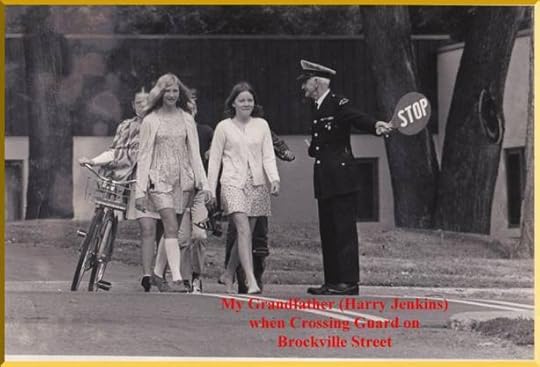
A new theater was built in 1949, at 15 Main Street in Smiths Falls. The new Soper Theatre boasted 964 seats, making it the largest movie theater in Eastern Ontario.
The Soper was managed by Walter Lackenbauer, a man who took his job very seriously. It was said that Walter was so punctual that you could set your watch when you saw him walking across the bridge, on his way to work each day.
When Walter Lackenbauer retired in 1976, Art White became the Manager of the Soper, and worked in that capacity until 1992, and then Jan Stepniak took over the position.

Another familiar face at the Soper Theatre was Violet Gariepy, a native of Scotland, she worked at the candy counter along with Norma Willoughby, and Jessie Loucks.
Below – the clock that hung on the wall in the concession counter at the Soper. *
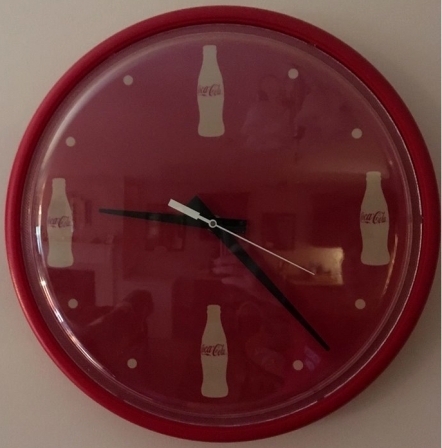
Some of the early films shown at the Soper, were tame compared to the movies produced today. Films like ‘Snow White’, and ‘Old Yellar’ were suitable for the whole family.

* * *

One of the most popular movies at The Soper Theatre in the 1950s was “The One That Got Away”, – the story of a German prisoner of war, Franz von Werra, who escaped from a moving train, as it passed through the town of Smiths Falls.

By the time I was old enough to attend a movie, the Soper Theatre was the only place in the area where we could go to see the newest Hollywood films. The Soper was just around the corner from the Sweet Shop – talk about a great location!
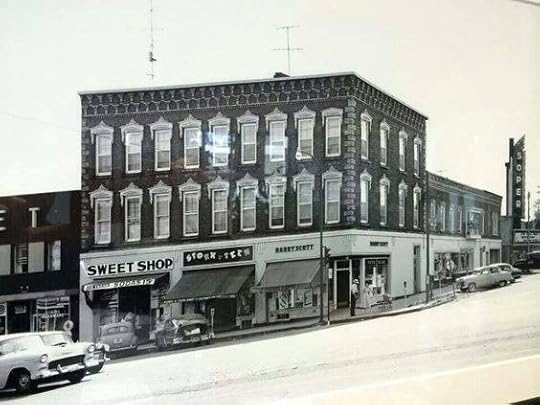
The Ushers who worked at the Soper Theatre might have been the original ‘multi-taskers’, who had a variety of jobs. These were the young lads who helped young children to their seats at the Saturday matinees, who shone their flashlights on young lovers in the back row, and did their best to keep the smoking and drinking from getting out of hand.

The ushers often walked back to the green seats, reminding smokers that their policy was cigarettes only, no cigars. They also had to police the drinkers, the kids who liked to sneak in mickey bottles in their jackets and have a few drinks on a Friday night.

The mickey, invented in Perth, by John McLaren, was just the right size to sneak into the movies!
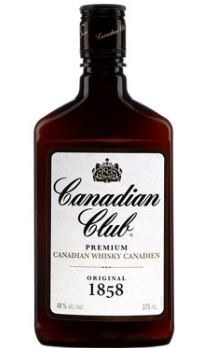
Some of the ushers who worked at The Soper, over the years: Gordon Evoy, Scott Irvine, Ralph Scott, Grant Dopson, Rob Knapp, Donnie Lackey, Ricky Laming, Tommy Martin, Bert Stranberg, Joe Gallipeau, John Marks, Brian McDougall, and Hugh Finlayson.
Many of us will not forget the big blockbuster movies in those days. According to many of the former staff members at the Soper, these movies were among the ones that brought in the biggest crowds in Smiths Falls:
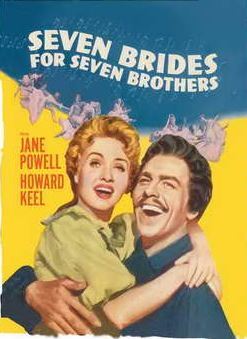
* * *


No one wanted to swim the year that this one came out!

Remember that great car! We all wanted one just like it.

Remember “Close Encounters”?

Who could ever forget the theme song from ‘Rocky’!

“Star Wars” was a great movie for kids growing up in the ‘space-age’.

On the opening day of Jurassic Park, staff members, like Tammy DeSalvo, dressed up as dinosaurs, much to the delight of local children!

Many of us remember the music from, “Titanic”, and the theme song sung by Celine Dion.

Sometimes we forget that it’s the people we don’t see at the movies, the ones who work behind the scenes, who play some of the most important roles. Rae Murphy was Projectionist at the Soper Theatre when the building was brand new, in 1949. The back-up Projectionist was Widge Williams, son of Bill Williams, owner of the Port Elmsley Drive-In Theatre.
Everyone’s favourite place at the Soper Theatre was the candy counter, and along with Violet Gariepy, you could find Gail Preece, and brother and sister team – Christine and Stephen Harper, and twins David Morris and Stephanie Morris. David later became a police officer for the Town of Smiths Falls.
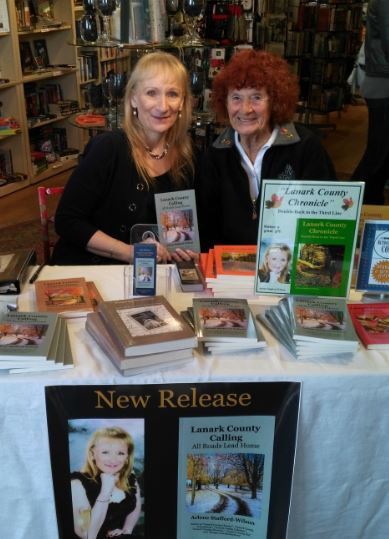

Many of us will never forget our very first movie, and for those of us who grew up in the area, the Soper Theatre was our first experience in a real movie theater.
The very first staff-member we encountered might have been Phyllis Evoy, at the ticket booth, or Violet Gariepy at the candy counter.

We may have noticed a very serious-looking man, Walter Lackenbauer, the Manager, walking around the lobby, making sure that everything was running smoothly. Maybe we’d catch a glimpse of Rea Murphy, on his way to the projection booth, or one of the helpful Ushers escorting a child, or an elderly person, safely to their seat.
Although most of us have been to more modern, slick, new theaters since our nights at the Soper Theatre, those special, magical nights of our youth will remain forever in our hearts.
* * *
*note – the photo of the red Coca-Cola clock that hung on the wall of the candy counter was provided by Violet Gariepy. Violet’s husband Raymond became ill, and Jan Stepniak visited Ray in the hospital. Ray told Jan how much he had always loved the clock from the candy counter. Jan came to their home later, and presented Ray with the clock. Ray sinced passed away, and the clock hangs proudly on Violet’s wall, a treasured memory of her time working at this much loved theater.Photos of the Soper Theatre: Steven Maddock of Hyfund StudioFor more information on John McLaren of Perth, inventor of the ‘mickey’John McLaren of Perth, inventor of the mickey…………………………..To read more about the heydays of the Soper Theatre: “Lanark County Calling: All Roads Lead Home”

Arlene Stafford-Wilson
Honorary Life Member, Lanark County Genealogical SocietyLanark County Pioneer Families Humanitarian AwardFrancois Bregha Storyteller AwardHeritage Perth Architectural Conservation AwardMember, Association of Professional GenealogistsAuthor of:“Lanark County Kitchen: A Maple Legacy from Tree to Table”, “Lanark County Christmas”, “Lanark County Comfort”, “Lanark County Collection”, “Lanark County Calling”, “Lanark County Classics”, “Lanark County Connections”, “Lanark County Calendar”, “Lanark County Chronicle”, “Lanark County Kid”, & “Recipes & Recollections”, and “Lanark County Classrooms: Remembering Our School Days”April 5, 2025
Garrett’s Rest – Rideau Lakes
Garrett’s Rest was a summer resort constructed in 1889 by Samuel Garrett, of Smiths Falls. At the time they opened the lodge, Samuel, was age 58, and his wife, Margaret (Garry) Garrett, was 59 and their 4 children – two sons, Bob, age 20, and John, 25, and two daughters Mary, 33, and Henrietta ‘Retta’, was 38.
Their lodge featured twenty well-appointed rooms for guests, and additional cabins were built on Exe Island to accommodate more seasonal guests. Some upgrades and renovations were completed at Garrett’s Rest during the 1899-1900 season. The dining room was enlarged, bedrooms were added, and a small grocery store and tuck shop was established. Even with the additional space, guests were frequently turned away during the summer months because they were often fully booked. Known as one of the most popular resorts on the Rideau, late summer visitors were mainly from Ottawa, Pennsylvania, and New York state.
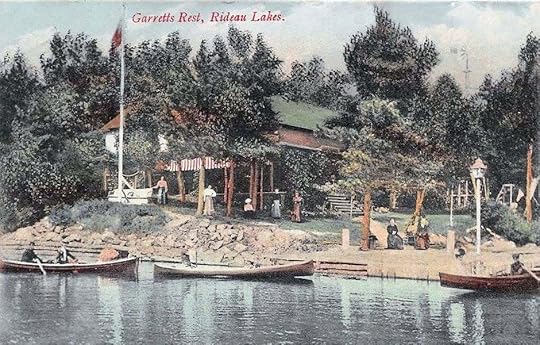
In the late 1880s, Captain Garrett, was owner and commander of the, “Ida”, which made weekly round trips from Kingston to Montreal, and was enormously popular with American and Canadian tourists, enjoying the river air and breathtaking scenery. In the summer of 1886 he was planning to build a much larger pleasure boat, at the cost of $16,000. The newer vessel was to be 108 feet keel, 30 feet beam, with 50 staterooms, bathrooms, a barber shop, and all of the desirable modern conveniences.
Beginning in 1892 Garrett’s Rest offered travel by steam yacht between Perth and Smiths Falls, and water taxi service between the islands and shores, into the 1920s, operated by Samuel’s son, Bob.
Many steamer services made scheduled stops at the island throughout the week. Religious services were offered on Sundays attracting hundreds of local cottagers, many who used their own personal craft to visit Garrett’s Rest. Dances were held at the resort, as well as meetings and events for local social clubs. The lodge also played host to some very prominent guests over the decades, like J.F. Frost of Smiths Falls. Frost brought a group aboard a steam yacht which included several distinguished members of parliament and other dignitaries.
(Garrett’s Rest may be seen in the map below in red)

Garrett’s Rest – located on a small island at the entrance to Briton Bay
Tour boats and pleasure craft alike were hugely popular, and stops along the Rideau Lakes for drinks, dinner, and lodging were favoured by affluent travelers.
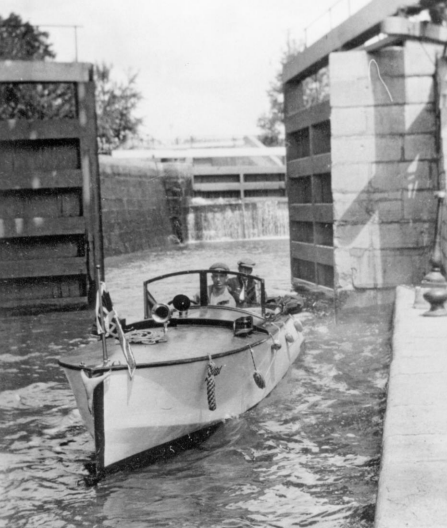
Below: A small steamer arriving at the dock at Garrett’s Rest, in the summer of 1910.
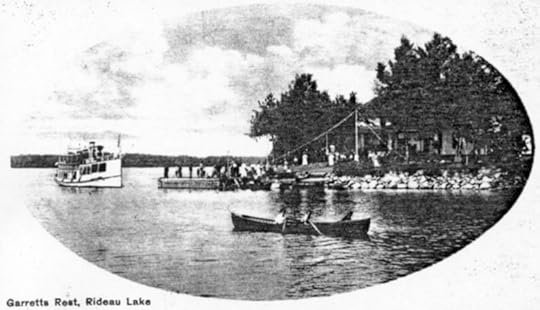
From the, “Rideau Record”, Smiths Falls – “One could not well imagine a pleasanter holiday than to take the round trip through the magnificent scenery of the Rideau Lakes, on this beautiful and commodious steamer…”
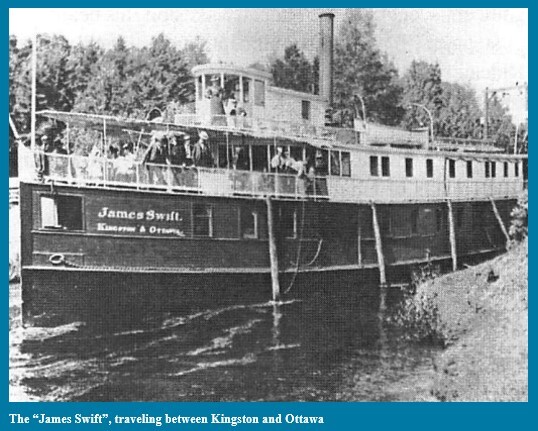
The ”Rideau Queen” offered sleeping accommodations for 75 passengers, featuring: “steam heat, electric lighting, electric fans, and cabins, priced from $1.00 to $5.00, with meals at 50 cents.”
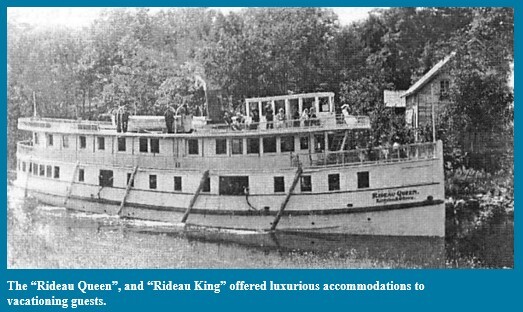
At one time there were very few resorts or guest accommodations along the route between Kingston and Ottawa.

Garrett’s Rest was tremendously popular, and often required booking several months ahead or more, due to returning guests, who visited during the same period each summer season.
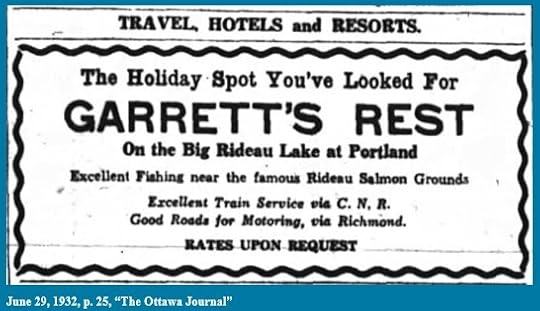
“Garrett’s Rest, Portland, Ontario: Beautiful place for a holiday. Splendid bathing, cool breezes, fishing for bass, salmon, trout and pike, right at the house. Wonderful scenery, healthful, splendid table, beach, yachting, no flies or mosquitoes!”

After the death of Samuel and Margaret Garrett, two of their children, Mary, and Robert ‘Bob’ took over the management of the hotel. Mary was in charge of the kitchen and hotel staff, and Bob provided transportation for guests in his water taxi.
Mary, age 52, was caught in a storm in the summer of 1913, with one of her young staff, out on the lake, in high winds and darkness. The local paper reported on her misadventures that evening:
“August 15, 1913
Mrs. Newton and Boy Saved in Rideau Lake.
“Smith’s Falls, Aug. 16.—Mary (Garrett) Newton, proprietress of Garrett’s Rest, Rideau Lake, had a trying experience recently. With a boy who works for her, she rowed to Portland to get some supplies and when they were ready for home it was almost dark and a high wind was blowing. They started and got part of the way over, but the storm got worse, the wind was blowing harder and the waves were rolling higher so that the boat began to take in water. She is an excellent boatwoman, and realized that her boat could not make time in such a gale. It was pitch dark, but she decided to make a landing on one of the islands. It was dangerous work, but she headed the boat for the shore and fortunately made it without upsetting or smashing the boat. They had to wade to get shore and had to make several trips back and forth to get the supplies on land. This was finally accomplished about 10.30 and she and the boy remained on the island all night until the wind went down in the morning. There was some anxiety at the Rest but it was thought they had stopped in Portland.”
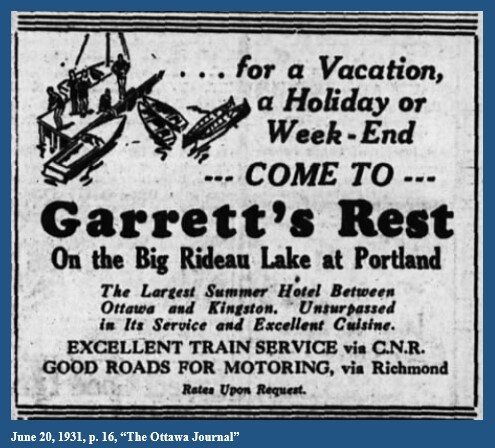
“For those who want absolute rest and pleasure the Upper Rideau offers the best advantages. It is one of the most delightful spots in all Canada. For boating, sailing, fishing, and scenery it has no equal. The accommodation at Garrett’s Rest is number one. The price is extremely moderate and the host and hostess the most genial and obliging to be found anywhere.”
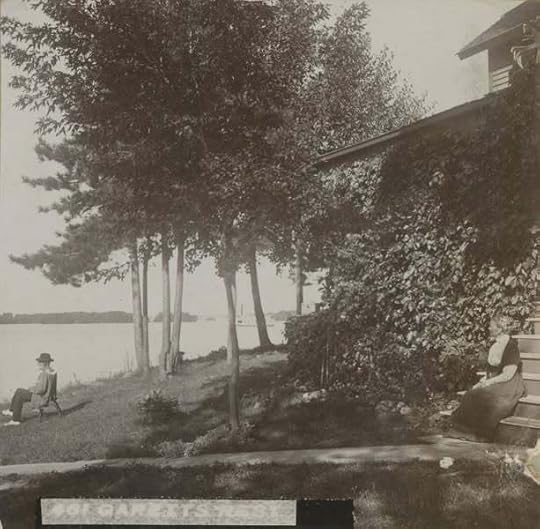
“During a week in the middle of July, there were twenty-nine boarders, seventeen from Smiths Falls, eight from Perth, and four from the United States.”
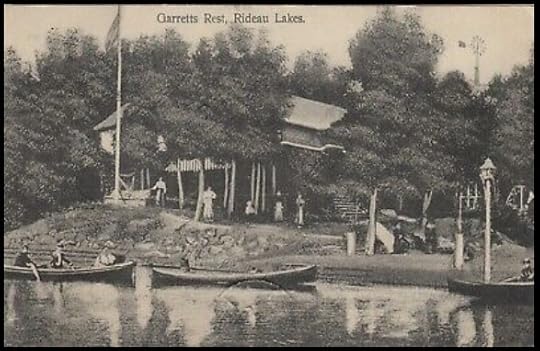
“At Garrett’s Rest: The Perth Regimental Band have kindly consented to give a concert Saturday afternoon, August 26th on the lawn. Dancing in the evening. Everybody on the lake and town are cordially invited to attend.” Mary (Garrett) Newton, and Bob Garrett, Proprietors.”
Aug. 25, 1922, p. 4, “The Perth Courier”
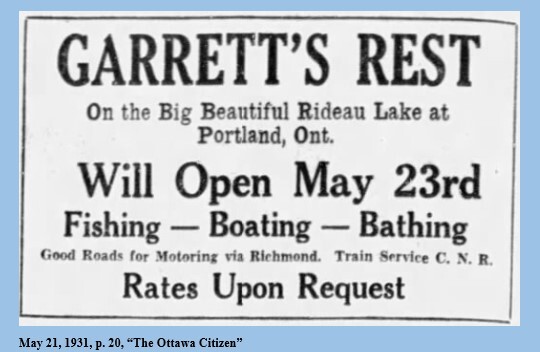
“Steamer Victoria News: Tuesday, Thursday and Saturday – Smiths Falls to Portland. Wednesday August 16th, leaving Perth at 9 a.m. to picnic grounds and Garrett’s Rest, returning at 6 p.m. Return trip to Perth or Smiths Falls – for: 50 cents. You can also return by midnight train.”
August 11, 1922, p. 1, “The Perth Courier”
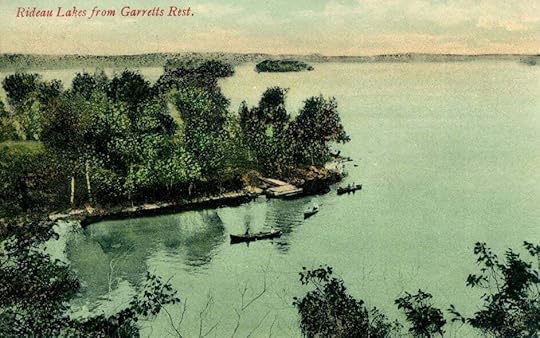
Captain Samuel Garrett passed away in December 1907, of heart failure, at age 76, and his wife, Margaret, passed away five years later, in 1912, at age 82, of ‘general weakness’. Their son, Bob, became a Captain on the Rideau, and operated a ferry service to and from the islands. He died of complications of bronchial pneumonia, in July of 1938, age 69. Their elder son, John Garrett, became a molder and was a foremen at Smiths Falls Malleable Co. He passed away at age 81, from a cerebral hemorrhage, in the summer of 1945. Henrietta ‘Retta’, married Albert Morgan, a Winnipeg merchant, and moved away from the area.
Mary (Garrett) Newton, was the last surviving member of the family. She continued to operate Garrett’s Rest, along with her brother, Bob, for twenty years following the death of their parents. Mary was well loved in the Rideau Lakes community, and was a dedicated member of the Portland Women’s Institute. At the time her her death, in the spring of 1946, at age 91, she was one of Portland’s oldest residents.
* * *
Garrett’s Rest was advertised for sale in the, “Ottawa Citizen”, in 1981: former resort, large private lot with 200 ft. frontage, access from marina or boat launching. Reduced to $45,000. Vendor take back first mortgage at 15%.
* * *
Garrett’s Rest will always be fondly remembered as part of the glory days of the luxury steam-ships, traveling up and down the Rideau between Kingston and Ottawa. Captain Samuel Garrett and his wife, Margaret, and their children, hosted many guests over the decades, ensuring that each and every one had a wonderful vacation, at that very special spot, on the scenic and memorable Rideau Lakes.
* * *
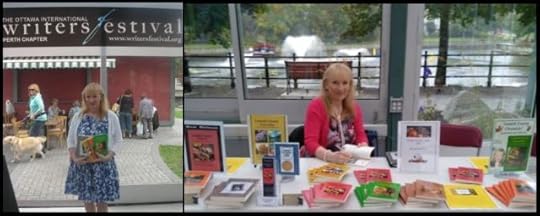
Arlene Stafford-Wilson
Honorary Life Member, Lanark County Genealogical Society
Lanark County Pioneer Families Humanitarian Award
Francois Bregha Storyteller Award
Heritage Perth Architectural Conservation Award
Member, Association of Professional Genealogists
Author of : “Lanark County Kitchen: A Maple Legacy from Tree to Table”, “Lanark County Christmas”, “Lanark County Comfort”, “Lanark County Collection”, “Lanark County Calling”, “Lanark County Classics”, “Lanark County Connections”, “Lanark County Calendar”, “Lanark County Chronicle”, “Lanark County Kid”, & “Recipes & Recollections”, and “Lanark County Classrooms: Remembering Our School Days”
Garrett’s Rest – Big Rideau
Garrett’s Rest was a summer resort constructed in 1889 by Samuel Garrett, of Smiths Falls. At the time they opened the lodge, Samuel, was age 58, and his wife, Margaret (Garry) Garrett, was 59 and their 4 children – two sons, Bob, age 20, and John, 25, and two daughters Mary, 33, and Henrietta ‘Retta’, was 38.
Their lodge featured twenty well-appointed rooms for guests, and additional cabins were built on Exe Island to accommodate more seasonal guests. Some upgrades and renovations were completed at Garrett’s Rest during the 1899-1900 season. The dining room was enlarged, bedrooms were added, and a small grocery store and tuck shop was established. Even with the additional space, guests were frequently turned away during the summer months because they were often fully booked. Known as one of the most popular resorts on the Rideau, late summer visitors were mainly from Ottawa, Pennsylvania, and New York state.

In the late 1880s, Captain Garrett, was owner and commander of the, “Ida”, which made weekly round trips from Kingston to Montreal, and was enormously popular with American and Canadian tourists, enjoying the river air and breathtaking scenery. In the summer of 1886 he was planning to build a much larger pleasure boat, at the cost of $16,000. The newer vessel was to be 108 feet keel, 30 feet beam, with 50 staterooms, bathrooms, a barber shop, and all of the desirable modern conveniences.
Beginning in 1892 Garrett’s Rest offered travel by steam yacht between Perth and Smiths Falls, and water taxi service between the islands and shores, into the 1920s, operated by Samuel’s son, Bob.
Many steamer services made scheduled stops at the island throughout the week. Religious services were offered on Sundays attracting hundreds of local cottagers, many who used their own personal craft to visit Garrett’s Rest. Dances were held at the resort, as well as meetings and events for local social clubs. The lodge also played host to some very prominent guests over the decades, like J.F. Frost of Smiths Falls. Frost brought a group aboard a steam yacht which included several prominent members of parliament and other dignitaries.
(Garrett’s Rest may be seen in the map below in red)

Garrett’s Rest – located on a small island at the entrance to Briton Bay
Tour boats and pleasure craft alike were hugely popular, and stops along the Rideau Lakes for drinks, dinner, and lodging were favoured by affluent travelers.

Below: A small steamer arriving at the dock at Garrett’s Rest, in the summer of 1910.

From the, “Rideau Record”, Smiths Falls – “One could not well imagine a pleasanter holiday than to take the round trip through the magnificent scenery of the Rideau Lakes, on this beautiful and commodious steamer…”

The ”Rideau Queen” offered sleeping accommodations for 75 passengers, featuring: “steam heat, electric lighting, electric fans, and cabins, priced from $1.00 to $5.00, with meals at 50 cents.”

At one time there were very few resorts or guest accommodations along the route between Kingston and Ottawa.

Garrett’s Rest was tremendously popular, and often required booking several months ahead or more, due to returning guests, who visited during the same period each summer season.

“Garrett’s Rest, Portland, Ontario: Beautiful place for a holiday. Splendid bathing, cool breezes, fishing for bass, salmon, trout and pike, right at the house. Wonderful scenery, healthful, splendid table, beach, yachting, no flies or mosquitoes!”

After the death of Samuel and Margaret Garrett, two of their children, Mary, and Robert ‘Bob’ took over the management of the hotel. Mary was in charge of the kitchen and hotel staff, and Bob provided transportation for guests in his water taxi.
Mary, age 52, was caught in a storm in the summer of 1913, with one of her young staff, out on the lake, in high winds and darkness. The local paper reported on her misadventures that evening:
“August 15, 1913
Mrs. Newton and Boy Saved in Rideau Lake.
“Smith’s Falls, Aug. 16.—Mary (Garrett) Newton, proprietress of Garrett’s Rest, Rideau Lake, had a trying experience recently. With a boy who works for her, she rowed to Portland to get some supplies and when they were ready for home it was almost dark and a high wind was blowing. They started and got part of the way over, but the storm got worse, the wind was blowing harder and the waves were rolling higher so that the boat began to take in water. She is an excellent boatwoman, and realized that her boat could not make time in such a gale. It was pitch dark, but she decided to make a landing on one of the islands. It was dangerous work, but she headed the boat for the shore and fortunately made it without upsetting or smashing the boat. They had to wade to get shore and had to make several trips back and forth to get the supplies on land. This was finally accomplished about 10.30 and she and the boy remained on the island all night until the wind went down in the morning. There was some anxiety at the Rest but it was thought they had stopped in Portland.”

“For those who want absolute rest and pleasure the Upper Rideau offers the best advantages. It is one of the most delightful spots in all Canada. For boating, sailing, fishing, and scenery it has no equal. The accommodation at Garrett’s Rest is number one. The price is extremely moderate and the host and hostess the most genial and obliging to be found anywhere.”

“During a week in the middle of July, there were twenty-nine boarders, seventeen from Smiths Falls, eight from Perth, and four from the United States.”

“At Garrett’s Rest: The Perth Regimental Band have kindly consented to give a concert Saturday afternoon, August 26th on the lawn. Dancing in the evening. Everybody on the lake and town are cordially invited to attend.” Mary (Garrett) Newton, and Bob Garrett, Proprietors.”
Aug. 25, 1922, p. 4, “The Perth Courier”

“Steamer Victoria News: Tuesday, Thursday and Saturday – Smiths Falls to Portland. Wednesday August 16th, leaving Perth at 9 a.m. to picnic grounds and Garrett’s Rest, returning at 6 p.m. Return trip to Perth or Smiths Falls – for: 50 cents. You can also return by midnight train.”
August 11, 1922, p. 1, “The Perth Courier”

Captain Samuel Garrett passed away in December 1907, of heart failure, at age 76, and his wife, Margaret, passed away five years later, in 1912, at age 82, of ‘general weakness’. Their son, Bob, became a Captain on the Rideau, and operated a ferry service to and from the islands. He died of complications of bronchial pneumonia, in July of 1938, age 69. Their elder son, John Garrett, became a molder and was a foremen at Smiths Falls Malleable Co. He passed away at age 81, from a cerebral hemorrhage, in the summer of 1945. Henrietta ‘Retta’, married Albert Morgan, a Winnipeg merchant, and moved away from the area.
Mary (Garrett) Newton, was the last surviving member of the family. She continued to operate Garrett’s Rest, along with her brother, Bob, for twenty years following the death of their parents. Mary was well loved in the Rideau Lakes community, and was a dedicated member of the Portland Women’s Institute. At the time her her death, in the spring of 1946, at age 91, she was one of Portland’s oldest residents.
* * *
Garrett’s Rest was advertised for sale in the, “Ottawa Citizen”, on November 5, 1981: 3 bedroom, 3 piece bath, large private lot with 200 ft. frontage, access from marina or boat launching. Reduced to $45,000. Vendor take back first mortgage at 15%.
* * *
Garrett’s Rest will always be fondly remembered as part of the glory days of the luxury steam-ships, traveling up and down the Rideau between Kingston and Ottawa. Captain Samuel Garrett and his wife, Margaret, and their children, hosted many guests over the decades, ensuring that each and every one had a wonderful vacation, at that very special spot, on the scenic and memorable Rideau Lakes.
* * *

Arlene Stafford-Wilson
Honorary Life Member, Lanark County Genealogical Society
Lanark County Pioneer Families Humanitarian Award
Francois Bregha Storyteller Award
Heritage Perth Architectural Conservation Award
Member, Association of Professional Genealogists
Author of : “Lanark County Kitchen: A Maple Legacy from Tree to Table”, “Lanark County Christmas”, “Lanark County Comfort”, “Lanark County Collection”, “Lanark County Calling”, “Lanark County Classics”, “Lanark County Connections”, “Lanark County Calendar”, “Lanark County Chronicle”, “Lanark County Kid”, & “Recipes & Recollections”, and “Lanark County Classrooms: Remembering Our School Days”
April 4, 2025
From Ireland to Perth
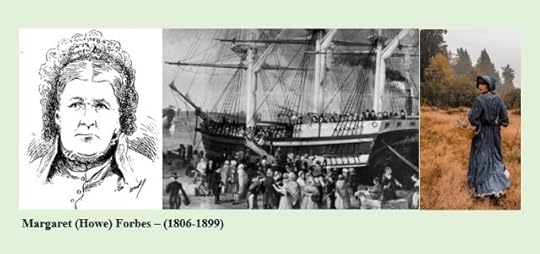
The following transcript was published in the, “Almonte Gazette”, on April 6, 1894, and is a first-hand account, oral recollection, of Margaret (Howe) Forbes, age 88, documented by her son-in-law for publication in the, “Arnprior Watchman”.
“A Pioneer’s Experiences: a trip from Ireland to New York, and from N.Y. to Lanark, seventy years ago, Mrs. Andrew Forbes’ interesting talk – hale and hearty at 88 years of age.”
“The engraving accompanying this article gives a good idea of the genial face of Mrs. Andrew Forbes, a lady of 88 years and wonderful vitality, whose experiences will not be uninteresting to the people in this section of the country, more especially as Mrs. Forbes has a wide connection and is known by a great many people in Lanark and Renfrew counties. Her memory is as clear as it ever was, and these scattered notes, taken from her own lips by her son-in-law, Mr. Henry Edey, were handed to the, “Arnprior Watchman”, for publication, Mrs. Forbes says:
“I was born in County Mayo, Ireland, in the year 1806, and sailed for New York in May,1822, experiencing a most unpleasantly rough passage, the voyage occupying no less than six weeks. We landed in New York on July 5th the day following the celebration of that event so dear to the American heart, Independence Day.

Arriving from overseas at the port of New York
Down the St. Lawrence
After three days at the metropolis, we proceeded up the American ‘Rhine’, (the Hudson River) by schooner, as far as Albany, then on to Rochester by canal boat. In those days the St. Lawrence River could only boast of two schooners, and it was on one of these, commanded by Captain McIntosh, that we set sail down the St. Lawrence, reaching the village of Prescott sometime during the night.
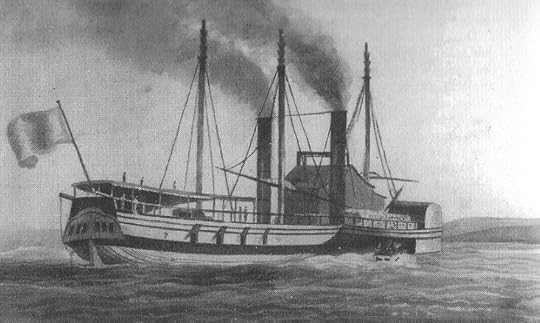
A schooner traveling along the St. Lawrence River – 1800s
Long Walk to Perth
From there we started for Perth, walking every foot of the distance, and being no less than two days on the road. We then made a start for Lanark, through the bush, our only means of guidance being the blaze or bark cut on the trees. In crossing the river Tay we experienced a little difficulty, the capacity of the vessel at our disposal being limited to two at a time. Our luggage remained in Prescott until the following winter. The river safely crossed, we wended our way through the woods for quite a distance, until we reached a clearing that was all on fire, and had not a kind-hearted man espied us at this point, we must surely have been lost. This man was a Mr. Hammond. He threw open the door of his not uncomfortable hut and bade us welcome until Monday morning. Mr. Hammond and his good wife, upon learning that we were Methodists, made things especially comfortable for us.
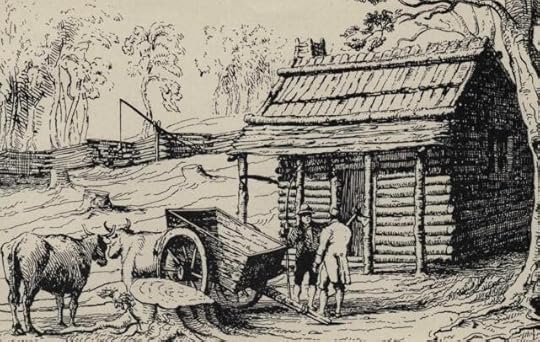
A pioneer log shanty
On Monday we arrived at a Mr. Riddell’s in Lanark. There were five in our party, my mother, father, brother John and sister, Annie Howe. Father, brother and sister went to Fitzroy while mother and I remained in Lanark during the winter. My brother James, in Fitzroy, had a home prepared for us, he having come out two years previous to this and settled on land. He told us many queer yet true incidents of his early experiences at Fitzroy.
A Lost Lunch
On one occasion he and his neighbour, Wm. McAdam, after a hard morning’s work, with keen appetites made their way back to a tree upon a limb of which they had suspended their dinner pail, but lo and behold! When they reached the spot there was no sign of the dinner pail; a bear had come along in the meantime and walked off with their provisions.
A Challenging Harvest
My brother cleared four acres and put it into fall wheat. In the spring of 1823 James and John went to Brockville to earn the price of a cow and yoke of oxen, leaving us at home to manage the little farm. Harvest time came, but we were at a loss to know how the crop was to be garnered. None of your improved implements in those days – not even a sickle, nor any other kind of a handy tool; so it fell to my lot to go to Shipman’s Mils (now Almonte) and procure them. The forest was fearfully dense between our place and the Mills, and the path through a remarkably narrow one. I was obliged to carry a lighted torch as protection from the mosquitoes. Having secured a couple of sickles from one Mr. Gemmill, who kept a small store where Almonte now stands, I started on the return trip home. I got within four miles of Pakenham when it became late and dark, and I went into a little shanty occupied by a Mr. and Mrs. Bowes. They declared I must remain with them overnight as wolves and bears were so numerous it was dangerous to be out after dark. I reached home next day about noon.
A Trip to Bytown
After our harvest was gathered, my brother John, my sister and myself, went to Bytown. I engaged with a Mr. Holester at Hull, while my sister engaged with an English minister, the Rev. Mr. Emsley; my brother secured work on the Sapper’s Bridge. I crossed over the Big Kettle, as it was called then, (Chaudière Falls on the Ottawa River), on boards suspended by a rope.
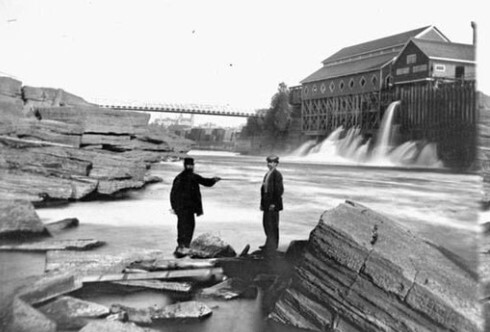
Old suspension bridge at the Chaudiere Falls – 1800s
Brother James’ Wedding
Five months passed and we returned home to attend my brother James’ wedding. He was married to Miss Hannah Flintoft, the Rev. Mr. Bell of Perth performing the ceremony. We repaired to the home of the bride’s father, spending the evening singing and dancing.

We carried our music with us – a fiddle – called a violin nowadays, I understand. We went from house to house with our fiddle and little keg, and every call was a real Irish call, you may be sure. Our teamster was kept in good spirits, and the next morning we drove to what is now known as Mohr’s Corners. (near Galetta, in Fitzroy Township) Here we arrived at Mr. Andrew Forbes’, a young man at that time, and enjoyed a jolly good time, after which we returned home. So ended the first wedding in America for me. I shall never forget it.
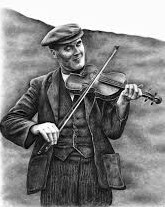
Margaret & Andrew
I made my home with my brother after his marriage, until I myself became the wife of Mr. Andrew Forbes, with whom, after keeping company for a space of about three years, I decided to cast my lot. Rev. Mr. Bell was again brought into requisition, the trip to Perth on this occasion, owing to the bad roads, being made on horseback. This was in March, 1826. We were married on the 1st of April, and I remember the clergyman warning my husband not to make an April fool of me. While in Perth we met in with two young men – William Halliday and Guy Landon. The latter was drowned above Arnprior.
* * *
Margaret and Andrew settled on a farm in Fitzroy, and were blessed with a large family of five sons and three daughters. They were married 59 years, and then, sadly, Andrew passed away, at age 78, in 1885. Of their children, only four were living at the time of Margaret’s death at age 94, in 1899: John, in Winnipeg, William, of East Louis, James, in Kinburn, and Andrew of Arnprior.
Personal accounts of these journeys from the old country, like Margaret’s, allow us a rare glimpse into those early days when our own ancestors arrived from faraway shores, to begin a new life. Some left for religious reasons, some for political reasons, many for economic reasons, and most imagined that their lives would be better than if they had remained back home. They were dreamers, optimists, and risk-takers, and their bold sense of adventure, and willingness to work hard laid the foundations for the prosperity of future generations.

The Irish who settled in Upper Canada made significant contributions to the way of life we enjoy today. It is estimated that over 1,000 Irish immigrants died during the construction of the Rideau Canal, some from malaria, and many more from accidents. A Celtic cross was erected in Ottawa, June 27, 2004, close to Lock # 1, below the Chateau Laurier Hotel. “In memory of an estimated one thousand Irish labourers and their co-workers who died of malaria and by accidents in terrible working conditions while building the Rideau Canal, 1826-1832.”
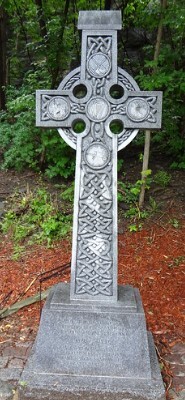
Arlene Stafford-Wilson
Honorary Life Member, Lanark County Genealogical Society
Lanark County Pioneer Families Humanitarian Award
Francois Bregha Storyteller Award
Heritage Perth Architectural Conservation Award
Member, Association of Professional Genealogists
Heritage Perth Architectural Conservation Award
Author of : “Lanark County Kitchen: A Maple Legacy from Tree to Table”, “Lanark County Christmas”, “Lanark County Comfort”, “Lanark County Collection”, “Lanark County Calling”, “Lanark County Classics”, “Lanark County Connections”, “Lanark County Calendar”, “Lanark County Chronicle”, “Lanark County Kid”, & “Recipes & Recollections”, and “Lanark County Classrooms: Remembering Our School Days”
April 1, 2025
A Pioneer’s Letter – 1842
“The following letter, written in the year 1842, by one of the pioneers of the Township of Ramsay, home to a relative in Scotland, will be interesting to the young people of the present generation, as it gives some idea of the toils and hardships which some of our early settlers were subjected to in emigrating to this country:”
(published in the “Almonte Gazette”, April 6, 1894, p. 2)

“I take the opportunity to let you know that we all got safely landed and are all in good health at present. Thanks be to God for it. Hope this will find you all the same. Now, I will give you a small account of our passage. We arrived at Glasgow, 30th May; sailed from there to Greenock 2nd June, sailed on 4th June to the tail of the bank, and lay all night until Sabbath evening, when we set sail for our new destination. On Tuesday, the 7th, as we came to the fresh channel we had a squall in the sea, and they all fell sick but Margaret and I. Agnes and Helen were sick for three weeks, but none of the rest of us were so bad.

Port at Greenock, Scotland
On the 29th, when we came on the first part of Newfoundland, we had a very rough night and day, which caused a great sickness again, but it was soon over. We had a fair wind all this time and a pleasant passage, but after that it got very cold and the days shorter. At the beginning of July, we had only fourteen hours of daylight. When we came to the second bank it was the 3rd of July and another rough day. Then we met a vessel bound for Limerick, Ireland, and the captains spoke to each other. We were told to look out for the ice, for they had come through a great many frozen mountains. We sailed for two days more and then came in sight of the ice, before night, passing a great many mountains of it. About sunset the captain was afraid that we would not get through one mountain that was in sight. He told us that he thought it was about four miles in length and 140 feet in height above the water, but we got safely through them.
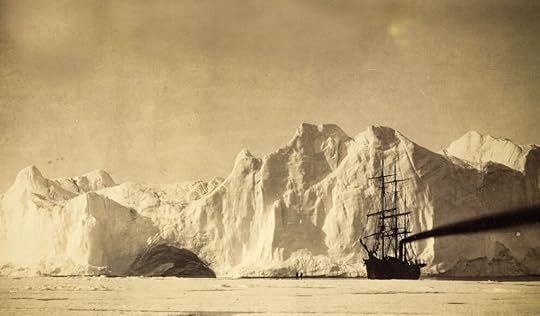
Icebergs – North Atlantic – 1800s
Then we came in sight of land, and there was great rejoicing. But we were disappointed, for we came into a mist and sailed five days and nights back and forth and never saw the sun. The captain did not know where he was. He told us he could soon run out of it, but was afraid the ship might run against some other ship or rocks and the passengers and crew would perish. The sun appeared on the 6th of July, and we got good hopes again. Then we got into the Gulf of St. Lawrence and had another very rough night and day again. Everyone thought that we would be lost. But we soon got over that. There was only one death – a child nine months old. The pilot told us there had been three ships lost on the Atlantic this season and not one of the people on board saved. When we came into the river, we saw a ship lying at Green Island without masts or rigging and the sailors living on the island. For 200 miles up the river it is the same as a town with houses on both sides. We stopped at the quarantine station at four in the morning and left at six o’ clock in the evening. We came to Quebec that night and lay all night there.
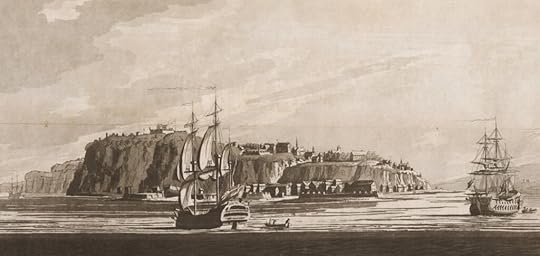
Port at Quebec – 1800s
We were towed up the river by a steamboat to Montreal in 74 hours. When we landed at Montreal there came an awful storm of thunder and hail. The like of the size of the hail I never did see. There was one cubic inch in each piece, and there was one passenger who went out to some acquaintances’ house and in that house the hail broke forty panes of glass. The planks were thrown off the ship that were put up for us to go ashore on. We were two days in Montreal and got a steamboat up the Rideau Canal and Grand River to Bytown.
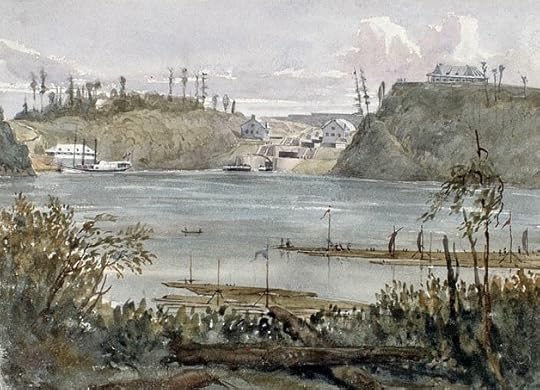
Bytown, entrance to the Rideau Canal as it appeared in 1838
Jessie and Margaret both had the measles but got very soon better of them. We were two days and nights in Bytown and hired a cart to take us to my brother’s place. That took us three days and two nights, for the roads are very bad. We all arrived on the 3rd of August, after nine weeks and three days from the time we left home.
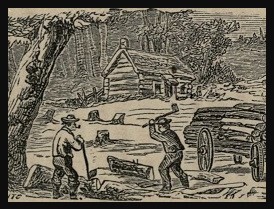
Settler’s home
We are now quite happy here. We have plenty of meat and work and have a good house to live in. I have got the offer of six dollars and board per week to go and be a miller, but I think I can do better than that on the farm. I had a visit from John Wallace and John Henderson’s son, but I have not had time to go and see them. I remain your affectionate brother,
William Lawrie, 8th Concession Township of Ramsay, District of Lanark, Canada, North America”
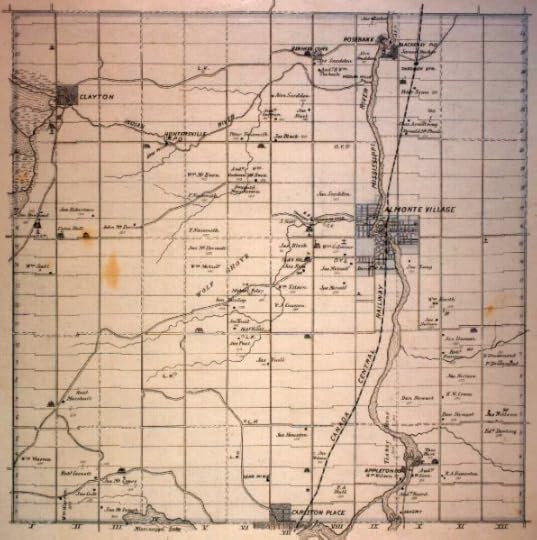
Map of Ramsay Township, Lanark County
Many of our ancestors had similar journeys, bringing them to their new homes in Lanark County. We are grateful to those, like William Lawrie, who shared the details of their historic and often harrowing voyages. It wasn’t easy leaving their families and friends behind and starting over in a new land with a harsher climate and unforeseen challenges. We are grateful for their hard work and perseverance, and through recording and sharing these personal accounts we will preserve their stories for future generations.
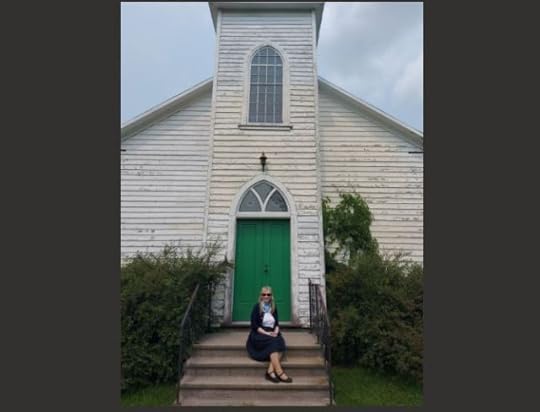
In front of St. Patrick’s Church, Ferguson’s Falls, Ontario – the community where our Stafford and McGarry ancestors settled after arriving from Ireland in 1816.
Arlene Stafford-Wilson
Honorary Life Member, Lanark County Genealogical Society
Lanark County Pioneer Families Humanitarian Award
Francois Bregha Storyteller Award
Heritage Perth Architectural Conservation Award
Member, Association of Professional Genealogists
Author of : “Lanark County Kitchen: A Maple Legacy from Tree to Table”, “Lanark County Christmas”, “Lanark County Comfort”, “Lanark County Collection”, “Lanark County Calling”, “Lanark County Classics”, “Lanark County Connections”, “Lanark County Calendar”, “Lanark County Chronicle”, “Lanark County Kid”, & “Recipes & Recollections”, and “Lanark County Classrooms: Remembering Our School Days”
March 31, 2025
McEwen’s Maple Baked Beans
Robert McEwen’s Pancake House, in Ferguson Falls, was the first of its kind in the region. It began as a centennial project, opened in 1967, with the intention of providing jobs for local youth.
Through their decades of operation, Robert and Kaye McEwen did indeed employ not only dozens of local youth, but many others from the community, both in the sugar bush, and the pancake restaurant.
“Local legends say that Dorothy Horricks, who lived next door to the McEwen’s, and worked at their restaurant, likely cooked at least one million pancakes over the years.”
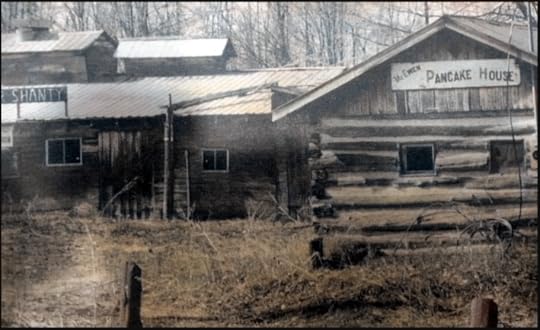
McEwen’s Pancake House, Ferguson Falls (1967-1993)
Although the ingredients are simple, this recipe became a well-loved and much in-demand dish at McEwen’s Pancake House, over the years.
“Maple syrup was used extensively by my mother, in all kinds of dishes, and her baked bean recipe was very popular.” Tom McEwen
Kaye (Huckabone) McEwen’s
Maple Baked Beans
Ingredients
3 c beans
1 tsp mustard
1/2 c maple syrup
1 tsp salt (if desired)
1/2 c butter
1/4 c tomato ketchup
Method:
Cover beans with water, and simmer for 2 hours.
Add mustard, maple syrup, salt, butter, and ketchup
Put in a baking dish and cover with water
Bake in a slow oven for several hours
Add more liquid as needed
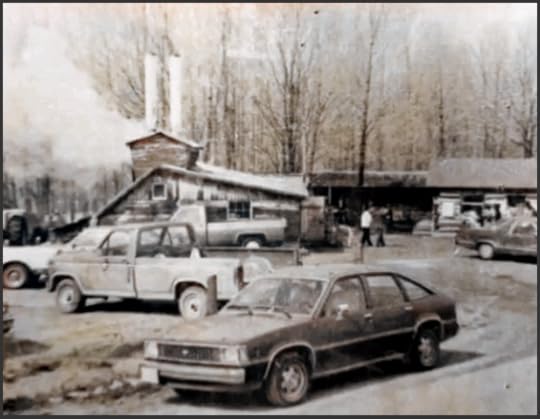
McEwen’s Pancake House and Sugar Bush
“Bob McEwen was one of the first maple producers in the area to install pipelines in the sugar bush, and he installed them for the 1968 season.”

Robert ‘Bob’ McEwen was a trailblazer in the close-knit community of maple syrup producers, and was continually embracing new methods and upgrading his equipment in order to achieve the highest possible standards of sap collection and processing.
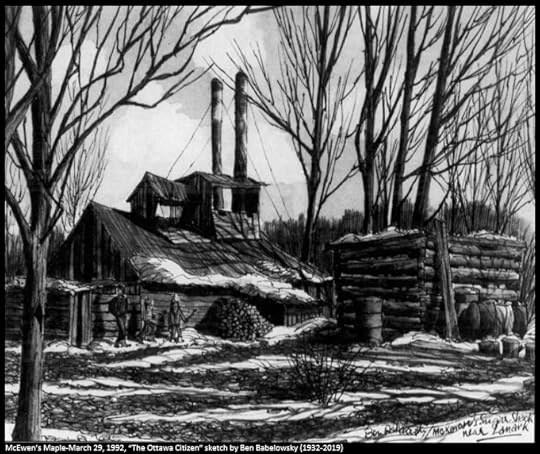
To commemorate the 25th Anniversary of McEwen’s Pancake House in 1992, – local artist, Ben Babelowsky (1932-2019) created an impressive work of art depicting the McEwen property, capturing this special moment in time.
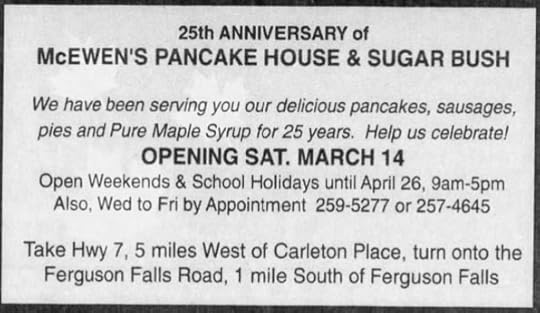
Mar. 11, 1992, p. 14, “The Ottawa Citizen”
Some of the surnames of the people (and youth) who worked at McEwen’s over the years:
Horricks, Beekman, Blair, McNaughton, Quinn, Ennis, Campbell, Mitchell, Hodgins, Lindenstruth, Closs, Bruneau, Eschke, Morris, Crosbie, Brittain, Couch, Dickenson, Vanderlaan, Badour, Hollington, Kelford, MacLaren, McCullough, Stach, Scott, Leuders…..
(The former McEwen’s Pancake House and Sugar Shack is now home to the award-winning Temple’s Sugar Bush……..another story of a legacy maple family, in the new book, “Lanark County Kitchen”.)

Who were Lanark County’s maple trailblazers? Who are the ‘legacy’ maple syrup producers whose families have been making maple syrup and maple sugar since the times of the early settlers?
Coutts, Dodds, Ennis, Fortune, Fulton, James, Oliver, Paul, Temple, Thompson, VanAlstine, Wheeler….
Meet the families with a long history of maple syrup-making, the award-winners, the names you know, the syrup that you love. Discover their stories, from the old days up to the present. Enjoy the special collection of heirloom maple recipes – some passed down through the generations, and some made popular in their own restaurants…
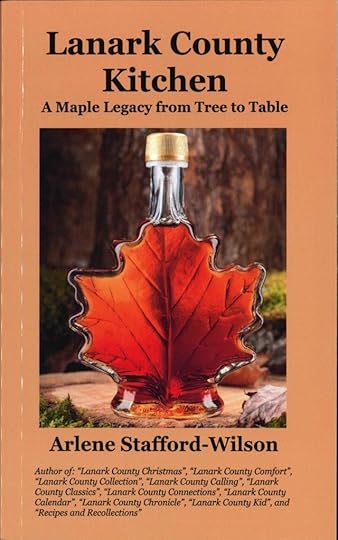
* * *

Arlene Stafford-Wilson
Honorary Life Member, Lanark County Genealogical Society
Lanark County Pioneer Families Humanitarian Award
Francois Bregha Storyteller Award
Heritage Perth Architectural Conservation Award
Member, Association of Professional Genealogists
Author of : “Lanark County Christmas”, “Lanark County Comfort”, “Lanark County Collection”, “Lanark County Calling”, “Lanark County Classics”, “Lanark County Connections”, “Lanark County Calendar”, “Lanark County Chronicle”, “Lanark County Kid”, & “Recipes & Recollections”, “Lanark County Kitchen: A Maple Legacy from Tree to Table”, and “Lanark County Classrooms: Remembering Our School Days”.
March 30, 2025
Winter Warriors
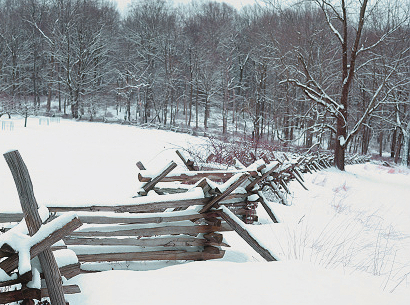
Eastern Ontario winters are not for the faint of heart. They are bitterly cold. They are relentless…and, they are long. They are not for the casual skier wanting a fashionable romp down a pretty hill only to return to the safety and warmth of their faraway homes. They are not for the frivolous winter vacationer staying at a rustic lodge to photograph a deer or a moose, from the comforts of their cozy cabin windows.
These winter days are for hardy souls only; all others need not apply. These are for people prepared to use a heavy shovel and an ever-present snow brush on a daily basis. These are for people possessing the knowledge and necessary techniques for walking on different types of ice…without falling. Some ice is flat and smooth like a hockey arena. Some ice is snow-covered, just enough to make the hidden surface even more perilous. Some days the ice is black, unseen, undetectable, rendering the walker completely unaware of their vulnerability.

This is where you’ll find the stalwart souls who soldier on, through ice and snow, from October through April each year, month after long winter month. These are the people who listen to reports of schools closing, and distant cities shut down because of the ‘bad’ winter weather, as they trudge through the snow on their way to work because it’s ‘just another day’. These are the people, young and old who wade through snow, stroll on the ice, and drive on slick roads in freezing rain, for months each year. Before their school day or work day has even begun, they have shoveled their sidewalks, brushed off their cars, stepped gingerly on ice, trudged through resistant snow drifts, all of this while bitter cold winds sting any skin unprotected by cumbersome layers of clothing and boots.

These are the enduring rank and file, possessing rare perseverance, stamina and patience. They are dreamers and unflinching optimists. In the final unbending weeks of the coldest season they will study seed catalogues, plan gardens, visit boat shows, and envision themselves under clear, blue skies on calm, warm, July afternoons. They conjure endless images of cottages, Muskoka chairs, hammocks, beer and barbecues. They dream of tulips and trilliums, green grass, and sunny days.
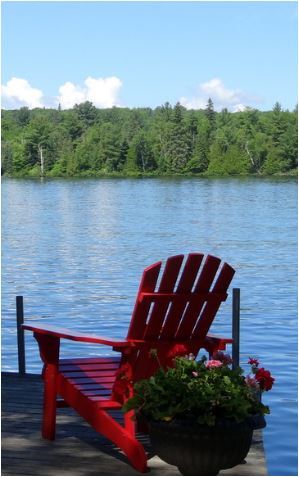
As the late winter unwinds its final few weeks in Eastern Ontario, perhaps the most anticipated signal to herald the new season for these enduring folks, will be the time-honoured, and always sublime, first taste of their beloved maple syrup. It spells the defeat, the finish, the finale, the wind-up, and the end-of-the-line for winter. It marks the beginning of spring, of brighter longer days, and the sweet, golden taste of victory for the hardy souls who have survived yet another long, cold Canadian winter.
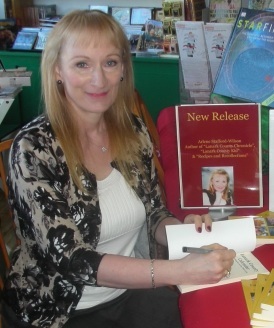
Arlene Stafford-Wilson
Honorary Life Member, Lanark County Genealogical SocietyLanark County Pioneer Families Humanitarian AwardFrancois Bregha Storyteller AwardHeritage Perth Architectural Conservation AwardMember, Association of Professional GenealogistsAuthor of : “Lanark County Christmas”, “Lanark County Comfort”, “Lanark County Collection”, “Lanark County Calling”, “Lanark County Classics”, “Lanark County Connections”, “Lanark County Calendar”, “Lanark County Chronicle”, “Lanark County Kid”, & “Recipes & Recollections”, “Lanark County Kitchen: A Maple Legacy from Tree to Table”, “Lanark County Classrooms: Remembering Our School Days”.Discover the history of maple syrup production in Lanark County, Eastern Ontario in ‘Taffy on the Tay’, an excerpt from “Lanark County Chronicle: Double Back to the Third Line”, – ISBN978-0-9877026-23March 19, 2025
Heritage Perth Architectural Conservation Award
Historic Gore Street in Perth looks even more inviting bathed in the warm light of spring, illuminating the familiar streetscape, with so many buildings proudly preserved, a scene that has for the most part remained steadfast through the centuries.
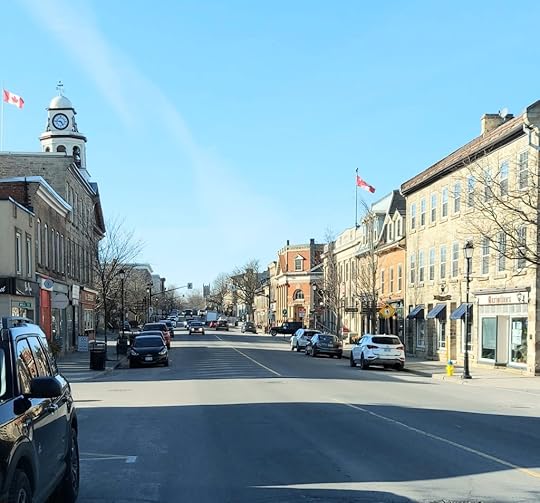
The ice is breaking up on the Tay River, a reminder of the rhythmic cycle of the changing seasons, constant, predictable, an end to Old Man Winter, as Sister Spring takes her place along the fields and meadows surrounding this pretty town.

As the Tay River rushes playfully under the bridge, it’s easy to imagine how this faithful old body of water served the early settlers, providing power for their mills, and a means of transportation for their goods.
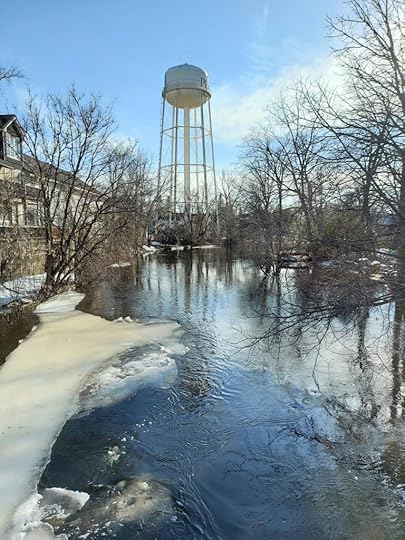
Perhaps one of the most historic structures in Perth is the majestic old Town Hall, rising tall along the main street, a symbol of the town’s government, its delightful clocktower imparting a sense of importance, and the flag a reassuring symbol of the stability of this old established community.

The plaque at the entrance to the Town Hall tells a wonderful story of the early history of the building and the vital role the structure and its occupants played in the establishment of order and organization as the town’s population expanded and flourished.
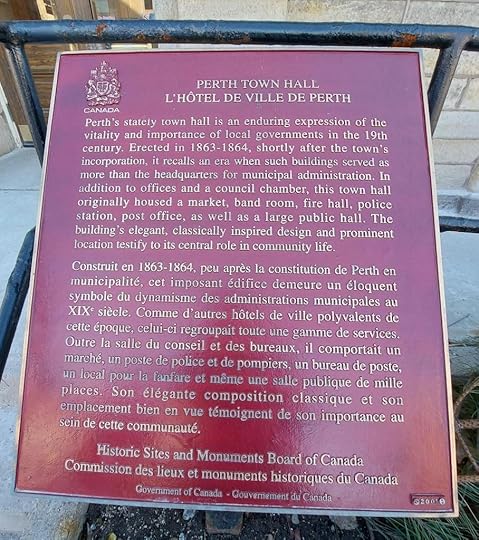
The Town Hall’s grand old staircase rises up majestically to the town’s Council Chambers, and the faces of those who served are proudly displayed, a reminder of the time, effort, and dedication required to establish and maintain a successful government to serve the people.

We were welcomed into the stately Council Chambers, greeted by many friendly faces, and meeting some new friends for the first time.
A short while into the Council meeting, it was time for the presentation of the Heritage Perth Architectural Conservation Awards – one given to Ron Shaw (who was not able to attend) and one to myself, both in the category of ‘Education’, for our efforts in documenting the history of some of the beautiful old buildings in Perth.
The award was presented by Mayor, Judy Brown, and Deputy Mayor, Ed McPherson.
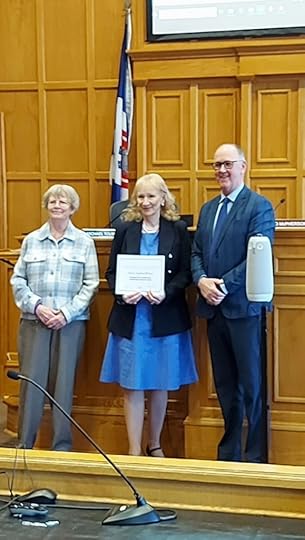
Award presentation with Mayor Judy Brown and Deputy Mayor Ed McPherson
* * *
It was an honour to receive this award, and to be recognized in such a meaningful way.

A fitting end to a wonderful day – a celebration with my husband, Kevin, to mark this special occasion.

Many thanks to the Mayor, the Deputy Mayor, Council Members and staff, of the Town of Perth, for your hospitality, kindness, and for making this such a special day; one that will remain a cherished memory for years to come.
Arlene Stafford-Wilson
Honorary Life Member, Lanark County Genealogical Society
Lanark County Pioneer Families Humanitarian Award
Francois Bregha Storyteller Award
Member, Association of Professional Genealogists
Author of : “Lanark County Kitchen: A Maple Legacy from Tree to Table”, “Lanark County Christmas”, “Lanark County Comfort”, “Lanark County Collection”, “Lanark County Calling”, “Lanark County Classics”, “Lanark County Connections”, “Lanark County Calendar”, “Lanark County Chronicle”, “Lanark County Kid”, & “Recipes & Recollections”, and “Lanark County Classrooms: Remembering Our School Days”
March 13, 2025
Ferguson’s Falls & The Stumble Inn
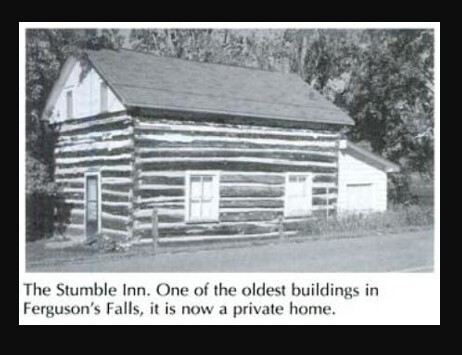 Photo: “A History of Drummond Township”, by John Ebbs, 1999, p. 21.
Photo: “A History of Drummond Township”, by John Ebbs, 1999, p. 21.Stumble Inn of Ferguson Falls
“It was a little shack very close to the old Mississippi, just across the bridge, coming down from the church; probably not room for more than twelve Irishmen at a time, if they could get along, and if that didn’t work, some would be out in yard ,or in the river.”
Thomas Joseph Stafford (1921-2018)
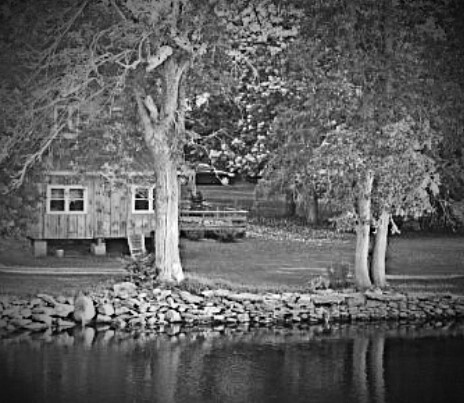 A view of the Stumble Inn from the Mississippi River
A view of the Stumble Inn from the Mississippi River“The Stumble Inn was operated by Billy McCaffrey. He was a very, very, short man, with a curved back. His tavern was located right beside the river, when you crossed the old bridge, across the Mississippi River, coming down from the Catholic church. I remember it around 1927 to early 1930s. The horses were stabled across the road in an open shed at Charles Hollinger’s, the auctioneer. We walked across the bridge up to church for mass. After mass the Catholic brethren would stop in at the Stumble Inn. You could get a shot of something for the trip home. There was also a lot of Poker played there, which was frowned on in the community. There were also lots of ghost stories told there.”
quote from 2012 by Thomas Stafford (1921-2018)
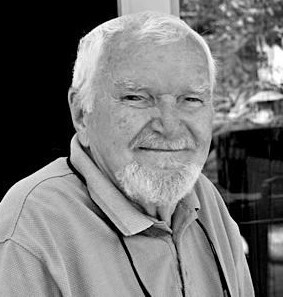 Thomas Stafford, son of Thomas Patrick Stafford and Margaret Doyle Stafford
Thomas Stafford, son of Thomas Patrick Stafford and Margaret Doyle Stafford“There would be music at the Stumble Inn. There was always music where the Irish gathered. I remember Jimmy (Richards) playing the fiddle. I spent quite a few days at Richards’ visiting with your dad ,Tib (Tobias Stafford). Clara (Richards Carberry) would feed us cookies. Jimmy thought we were a pain in the ass, I think. Peter (Stafford) was a great fisherman of mud pouts from the old Mississippi. In Ferguson Falls they were all related, either before or after they arrived in Canada from Wexford.”
(quote from Thomas ‘Tom’ Stafford 1921-2018)
(James ‘Jimmy’ Richards was Dad’s uncle on his Mother’s side. Clara Richards, Dad’s aunt, was Jimmy’s sister. Clara Richards married Thomas ‘Tom’ Carberry, a descendant of one of the ‘Seven Irish Bachelors’ of Ferguson Falls. The Richards homestead was next door to the Stafford homestead on the 11th concession of Drummond Township. Dad’s parents – Anastasia ‘Stacy’ Richards married Michael Vincent ‘Vince’ Stafford – the boy next door) Peter Stafford was Dad’s brother) ‘Wexford’ refers to County Wexford, Ireland. Jimmy Richards played his fiddle at the Stumble Inn on a regular basis. His fiddle was passed down to Dad, then to me.)
Billy McCaffrey, owner of The Stumble Inn
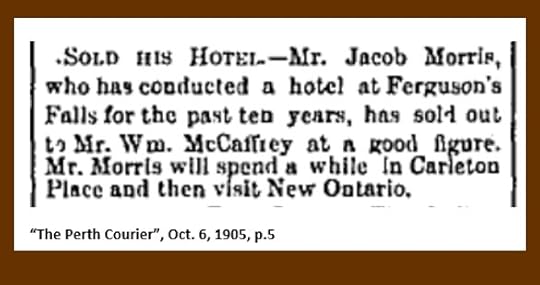
William Henry ‘Billy’ McCaffrey, (1869-1940), was the son of Joseph McCaffrey, and Ellen McGarry McCaffrey. Billy’s ancestor, Thomas McCaffrey was the first settler and resident of the village of Ferguson Falls, arriving in 1815.
Billy’s mother, Ellen McGarry McCaffrey:
 Ellen McGarry McCaffrey 1837-1917
Ellen McGarry McCaffrey 1837-1917Ellen McGarry McCaffrey and her husband, Joseph McCaffrey had ten children:
Mary McCaffrey 1861-1944 – was a tailorJulia Ann McCaffrey 1863-1944Thomas McCaffrey 1866-1913. Thomas married Margaret Doyle and they lived on the McCaffrey homestead on the 8th concession of Drummond Township. Thomas died age 46 of tuberculosisPeter McCaffrey 1867-1895 – died age 28 of dropsyWm. Billy McCaffrey 1868-1940 – saddler by trade, owned a hotel in Ferguson Falls, and later, owned the Stumble InnMargaret McCaffrey 1874-1917 died age 43 of pernicious anemiaLoretta McCaffrey 1872-1941 was a dressmakerGertrude McCaffrey 1875-1918 died age 38 of pernicious anemiaJosephine McCaffrey 1877-1931 trained as a nurse and worked in New York, died age 52 of cerebral hemorrhageTeresa McCaffrey 1879-1935, married Martin Sylvester Grace. Their children: Harold Francis Grace, Ursula Grace Kehoe Bent, Helen Grace Butterworth, Kathryn Grace Daley, and Reverend Sister Anna Gertrude.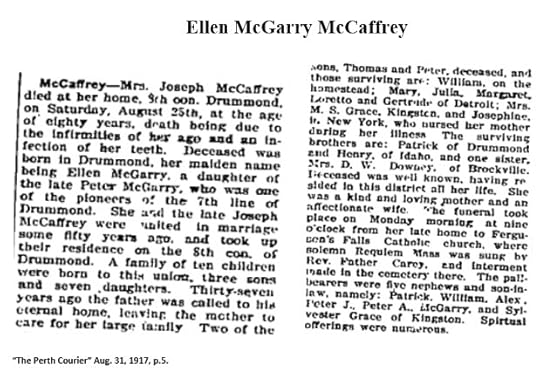 Ellen McGarry McCaffrey, daughter of Peter McGarry, niece of pioneers Elizabeth McGarry Stafford and Tobias Stafford
Ellen McGarry McCaffrey, daughter of Peter McGarry, niece of pioneers Elizabeth McGarry Stafford and Tobias StaffordAfter operating his successful and much-loved community gathering spot, the Stumble Inn, Billy passed away in 1940.
“The late Mr. McCaffrey was a man of sterling qualities, and possessed the good-will and esteem of all who knew him.”
 Billy McCaffrey’s obituary from “The Perth Courier” Aug. 2, 1940, p.3
Billy McCaffrey’s obituary from “The Perth Courier” Aug. 2, 1940, p.3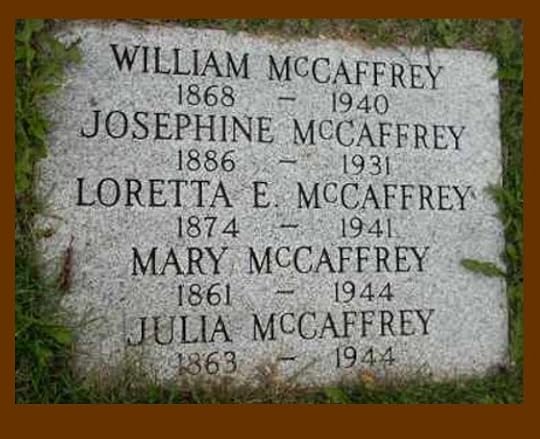 Billy’s and some of his siblings, St. Patrick’s cemetery, Ferguson Falls
Billy’s and some of his siblings, St. Patrick’s cemetery, Ferguson FallsFerguson Falls
(sometimes written as Ferguson’s Falls, or Fergusons Falls, depending on the era)
Originally known as Milford, Fergusons Falls was renamed in honor of the early settler Captain Ferguson when a post office was established there. This was the closest village to the Stafford farm and was a source for supplies, postal services, blacksmith services, social activities, and later St. Patrick’s Church.
Thomas McCaffrey was the first settler coming in 1815. McCaffrey was a close friend of Tobias Stafford and Betsy (McGarry) Stafford. Thomas was one of the witnesses to their marriage ceremony in St. John’s Church in Perth. He also signed his name as witness to one of Tobias’ later land transactions, and was present at the baptisms of some of the Stafford children.
Other early Ferguson Falls residents were John and Patrick Quinn, Patrick and Martin Doyle, James Carberry, James Power and William Scanlon. Two Stafford girls married into the Quinn family. The Hollinger family was also among the first settlers. By 1857, Ferguson Falls was booming. John Doyle was the Innkeeper, James McCaffrey was listed in the business directory as a Wagon Maker, and John & Michael McCaffrey were the local Blacksmiths. John Stafford, Tobias Stafford and Elizabeth McGarry’s son, was the area Shoemaker, and would later open a shoe store in Almonte, then in Perth. There was also a saw-mill, and a grist mill owned by Robert Blair and a hotel owned by Charles Hollinger.
Some history of Ferguson Falls:
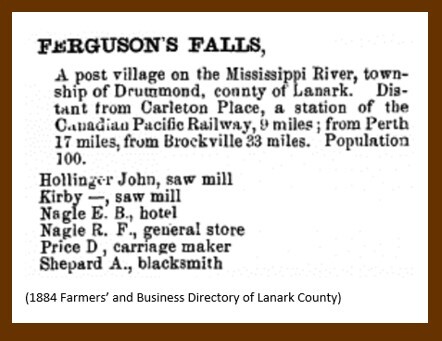 1884 Farmers’ and Business Directory
1884 Farmers’ and Business Directory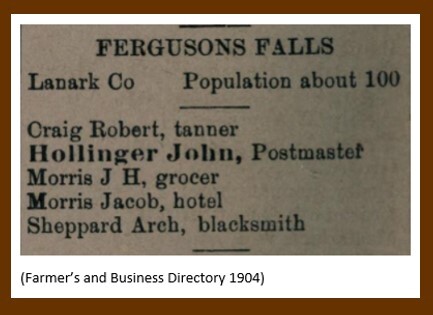 1904 Business Directory for Lanark County
1904 Business Directory for Lanark County 1916 Farmers’ and Business Directory for Lanark County
1916 Farmers’ and Business Directory for Lanark CountyA note on the local school:
“In 1894 Miss Mary Stafford taught, and then in 1901-1909 Miss Maggie Doyle of Drummond Twp (who later married Thomas Patrick Stafford).
In 1901 the teacher’s salary was $240.00 dollars a year. In 1905 it was $250.00. 1943-1946 Miss Mary Phelan of Lanark was the teacher. Her salary was $1000.00 a year and she had 9 pupils.”
(quote from Gail McFarlane, taken from the Tweedsmuir history of Ferguson Falls)
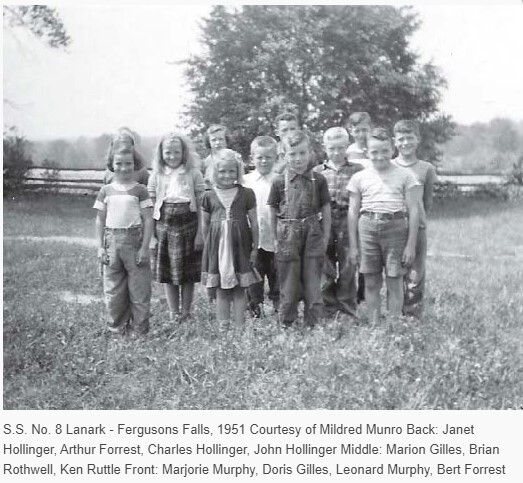
 S.S. # 15 Drummond Township School, class of 1928-29, with our cousins, Thomas ‘Tom’ Stafford (1921-2018) , Patricia ‘Pat’ Stafford, and Nora Stafford, (children of Thomas Patrick Stafford and Margaret ‘Maggie’ Doyle Stafford) Original photo at the Lanark Museum.
S.S. # 15 Drummond Township School, class of 1928-29, with our cousins, Thomas ‘Tom’ Stafford (1921-2018) , Patricia ‘Pat’ Stafford, and Nora Stafford, (children of Thomas Patrick Stafford and Margaret ‘Maggie’ Doyle Stafford) Original photo at the Lanark Museum.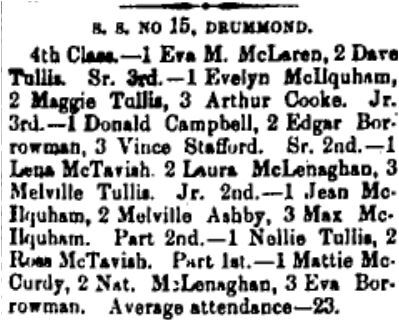
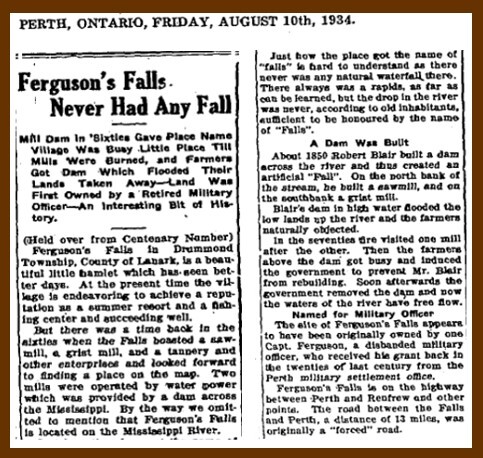 “The Perth Courier”, August 10, 1934 part 1 of 3
“The Perth Courier”, August 10, 1934 part 1 of 3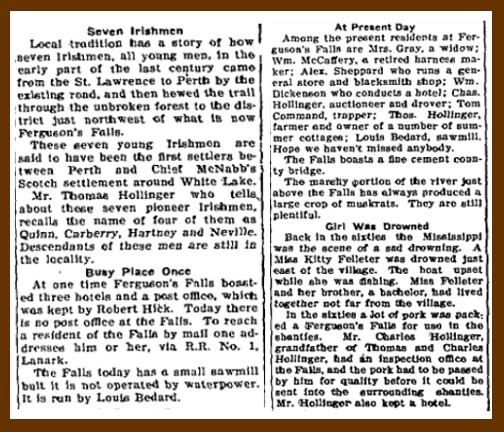 “The Perth Courier”, August 10, 1934 part 2 of 3
“The Perth Courier”, August 10, 1934 part 2 of 3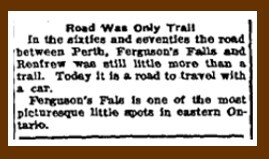 “The Perth Courier”, August 10, 1934 part 3 of 3
“The Perth Courier”, August 10, 1934 part 3 of 3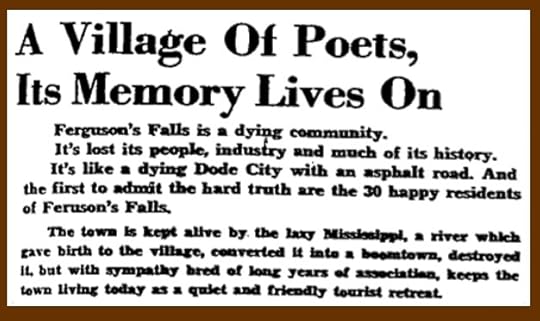 “The Perth Courier” Sept. 13, 1962, p.3
“The Perth Courier” Sept. 13, 1962, p.3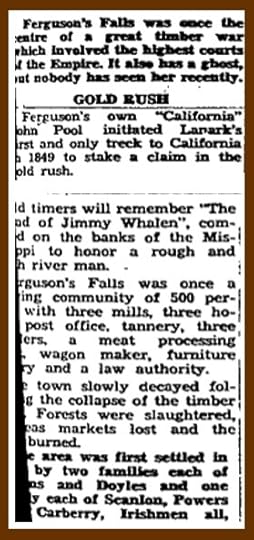 “The Perth Courier” Sept. 13, 1962, p.3
“The Perth Courier” Sept. 13, 1962, p.3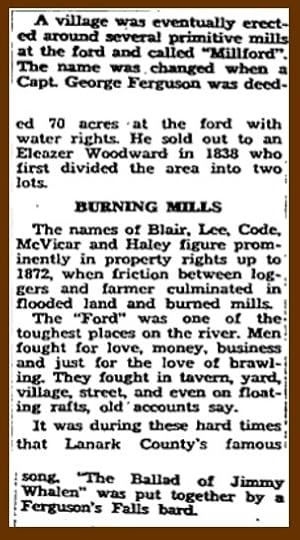 “The Perth Courier” Sept. 13, 1962
“The Perth Courier” Sept. 13, 1962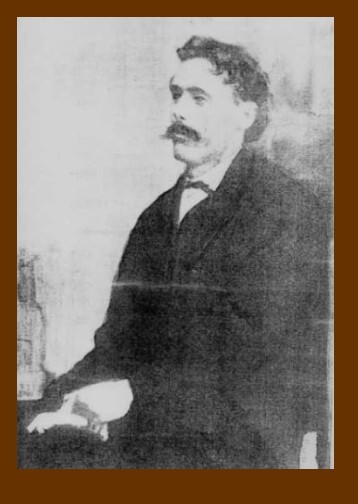 James ‘Jimmy’ Phelan (pronounced Whelan) Local lore says his lost love wanders in Ferguson Falls, along the Mississippi River at night, searching for Jimmy. The Phelan farm backed directly onto the Stafford homestead on the 11th concession of Drummond Township. Tim Doyle of Lanark village is said to have written the song.
James ‘Jimmy’ Phelan (pronounced Whelan) Local lore says his lost love wanders in Ferguson Falls, along the Mississippi River at night, searching for Jimmy. The Phelan farm backed directly onto the Stafford homestead on the 11th concession of Drummond Township. Tim Doyle of Lanark village is said to have written the song.Ballad of Jimmy Whelan
All alone as I strayed by the banks of the river
Watching the moonbeams as evening drew nigh
All alone as I rambled, I spied a fair damsel
Weeping and wailing with many a sigh.
Weeping for one who is now lying lowly
Mourning for one who no mortal can save
As the foaming dark water flow gently about him
Onward they speed over young Jimmy’s grave.
She cries, “Oh, my darling, please come to me quickly
And give me fond kisses that oft-times you gave
You promised to meet me this evening, my darling
So now, lovely Jimmy, arise from your grave.”
Slowly he rose from the dark, stormy waters
A vision of beauty more fair than the sun
Saying “I have returned from the regions of glory
To be in your dear loving arms once again.”
“Oh, Jimmy, why can’t you tarry here with me
Not leave me alone, so distracted in pain.”
“Since death is the dagger that’s cut us asunder
Wide is the gulf, love, between you and I.”
“One fond embrace, love, and then I must leave you
One loving farewell, and then we must part.”
Cold were the arms that encircled about her
Cold was the body she pressed to her heart.
Slowly he rose from the banks of the river
Up to the heavens he then seemed to go
Leaving this fair maiden, weeping and mourning
Alone on the banks of the river below.
(local Irish legends told of the ‘gates of glass’, where one could pass between this world and the next, through the water of a lake or river, at dusk)
 “The Perth Courier” continued from article above
“The Perth Courier” continued from article above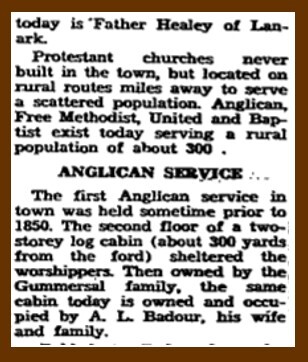 “Perth Courier” article – continued
“Perth Courier” article – continued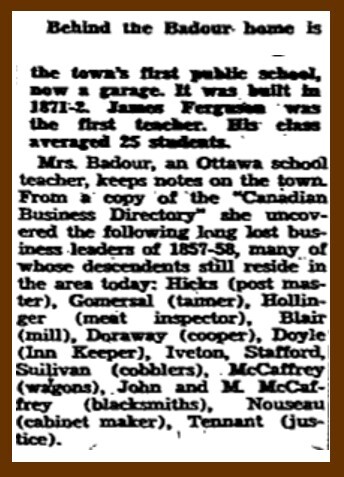 “Perth Courier” article continued
“Perth Courier” article continued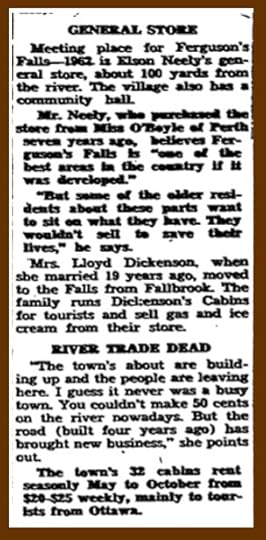 “The Perth Courier” – article continued
“The Perth Courier” – article continued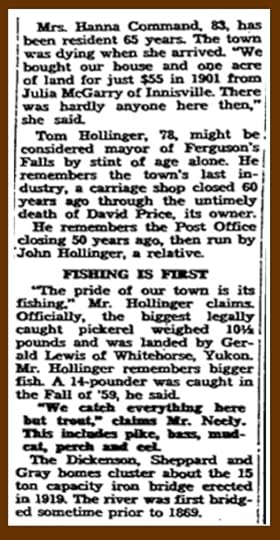 “The Perth Courier” – article continued
“The Perth Courier” – article continued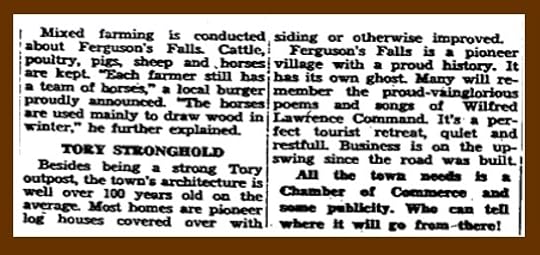 “The Perth Courier”, Sept. 13, 1962, p3, end of article
“The Perth Courier”, Sept. 13, 1962, p3, end of articleA Return to Our Roots in 2012
Archives Lanark celebrated their 10th Anniversary in October of 2012, at the Ferguson’s Falls Community Hall. There were local dignitaries from Drummond Township, and Doug Bell made a presentation of a 200 year old artifact, – an original settler’s trunk from pioneer Sutton Frizzell, and his land documents that were found in the trunk.
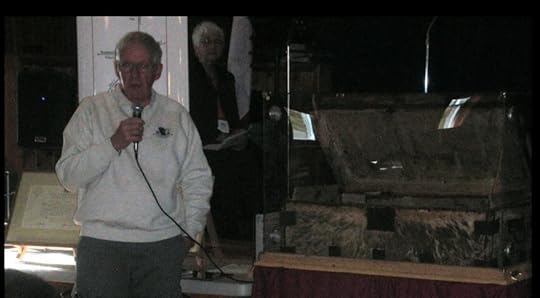 Sutton Frizell’s trunks presented by Doug Bell to Archives Lanark
Sutton Frizell’s trunks presented by Doug Bell to Archives Lanark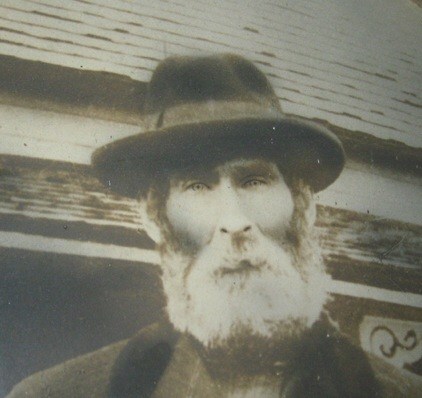 Sutton Frizell, one of the first elected Councillors in Drummond Township in 1850, along with Thomas McCaffrey, Murdock McDonald, Patrick Dowdall, and John Thompson
Sutton Frizell, one of the first elected Councillors in Drummond Township in 1850, along with Thomas McCaffrey, Murdock McDonald, Patrick Dowdall, and John ThompsonThere were also displays showing some highlights of the work that the Archives has done, and the variety of resources available for local researchers.
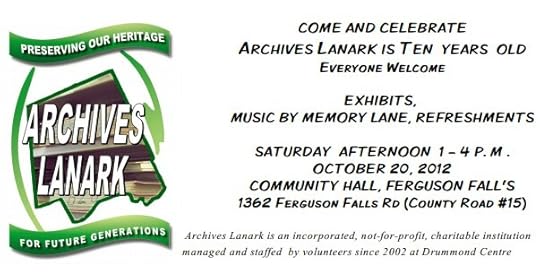
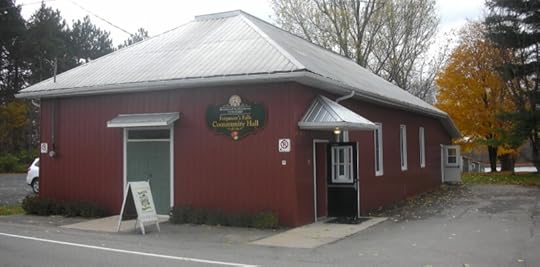 Ferguson Falls Community Hall, Oct. 12, 2012
Ferguson Falls Community Hall, Oct. 12, 2012 Archives Lanark 10th anniversary 2012 – entertainment by ‘Memory Lane’, Mark Labelle on guitar on far left, Leo Scissions on guitar, with Heather Johnston on fiddle, and Jack Greer on banjo. (thanks to Stacey Horne, Arlene Quinn, and others who provided the names of the band members)
Archives Lanark 10th anniversary 2012 – entertainment by ‘Memory Lane’, Mark Labelle on guitar on far left, Leo Scissions on guitar, with Heather Johnston on fiddle, and Jack Greer on banjo. (thanks to Stacey Horne, Arlene Quinn, and others who provided the names of the band members)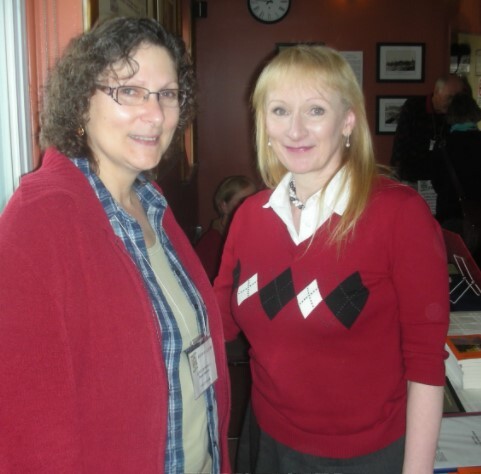 Archives Lanark 10th Anniversary in 2012, with Lanark County Genealogical Society (past) President Janet Dowdall (left) , and LCGS member, Arlene Stafford-Wilson
Archives Lanark 10th Anniversary in 2012, with Lanark County Genealogical Society (past) President Janet Dowdall (left) , and LCGS member, Arlene Stafford-Wilson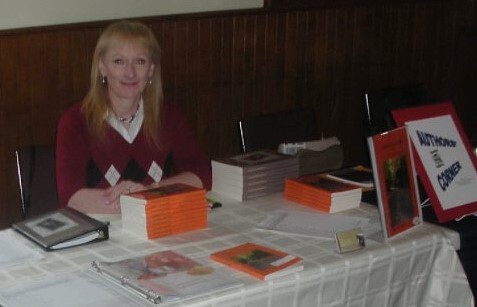 Arlene Stafford-Wilson at the Authors Corner, Ferguson Falls Community Hall, October 2012
Arlene Stafford-Wilson at the Authors Corner, Ferguson Falls Community Hall, October 2012Autumn in Ferguson Falls
 quote from “Lanark County Connections: Memories Among the Maples”
quote from “Lanark County Connections: Memories Among the Maples”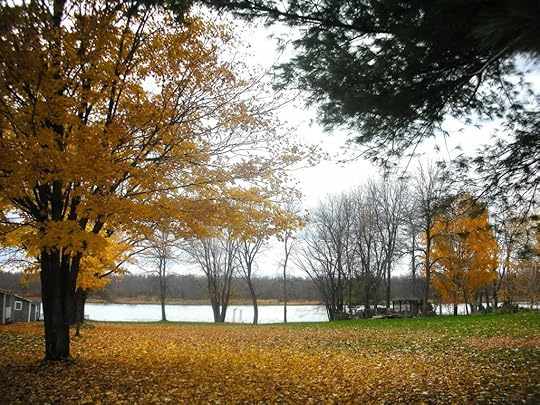 Picturesque Ferguson Falls, along the Mississippi River
Picturesque Ferguson Falls, along the Mississippi RiverStafford family Sunday drives in the 1960s and 1970s began on the Third Line of Bathurst, often involved detours though Balderson and Lanark village, but they always seemed to end up at Ferguson Falls. Our father was born and raised on the 11th concession of Drummond Township, on the ancestral Stafford farm, settled by pioneer, Tobias Stafford in 1816. Our ancestor spent his first year on what became known as Stafford Island on the Mississippi River before building a home.
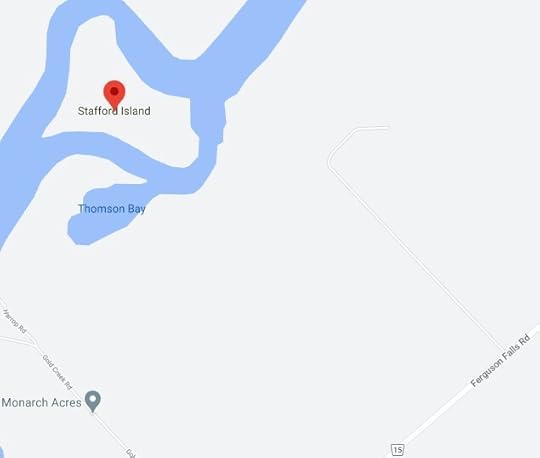
In the earliest days of the settlement, priests would travel to these small communities, and Sunday mass would be held in someone’s home. Once St. John’s Church in Perth was built, the pioneers travelled by horse and buggy, or horse and cutter, to attend services, until 1856, when St. Patrick’s Church was established, along the river.
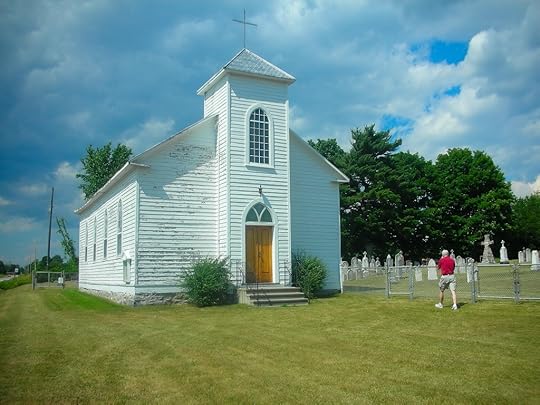 St. Patrick’s Roman Catholic Church, and my brother, Roger Stafford, in Ferguson Falls
St. Patrick’s Roman Catholic Church, and my brother, Roger Stafford, in Ferguson Falls
Sunday Drives…..
…And so, we returned again and again to Ferguson Falls on our Sunday drives; to the pretty village in Drummond Township. We listened to our father’s accounts of the glory days of the Prestonvale ball team, and the long walks to S.S. # 16 Drummond School in snowstorms. We always stopped at St. Patrick’s church, and walked up and down through the rows of the graves of our ancestors. Dad’s parents were buried there, and his grandparents, and the oldest ones, who had come from Ireland. The old families were all connected by marriage – Quinn, McKittrick, Richards, Carberry, Carroll, Ryan, McCaffrey, and the rest; and he pointed to the headstones as we walked through the rows.
There were always stories of the infamous Stumble Inn, across the bridge from the church, and the card-games, and the drinking, and the fighting. We heard about Billy McCaffrey and how he sold whiskey at all hours of the day and night from his modest establishment. We learned of the Hollinger family and the generations of local auctioneers, and their busy hotel that catered to loggers. The loggers danced in their spiked boots and old Charlie Hollinger had to replace the floors once a year. We heard about the McEwen family and visited their popular maple shack in the spring. We heard the local names over and over: Blair, McFarlane, Horricks, Rathwell, Cullen and Kehoe.
We learned that the Irish Roman Catholics were a devoted bunch, loyal to their church, but also possessed an entirely different belief system that included ghosts and fairies, and the little people. We heard about Jimmy Whalen, a neighbour to the Stafford family, and how his lover could still be seen late at night walking along the banks of the Mississippi River, searching for her long lost Jimmy. We listened to stories about the lumber wars in the old days between the McLaren and Caldwell families, and the yearly cattle drives to Carleton Place.
The Sunday drive always ended the same way, with a visit to Lloyd and Evelyn Dickenson’s store for an ice cream cone and a bottle of Pure Spring pop. Dad and Lloyd talked about the old days, and walked together along the shore, near the cottages, recounting tales of catching bullfrogs, and fishing in the river.
I miss our drives to Ferguson Falls, and stopping for a bag of curd at the Balderson Cheese Factory along the way, visiting the graves of our ancestors, walking where they walked, and hearing the stories of the good old days. Dad, and his cousin Tom are gone now, but their stories live on. I often wonder if they told the same stories again and again so that we would remember; remember the place where the ancestors settled, remember the customs and legends from the old country, remember so that we could tell their stories, of this special place, called Ferguson Falls.
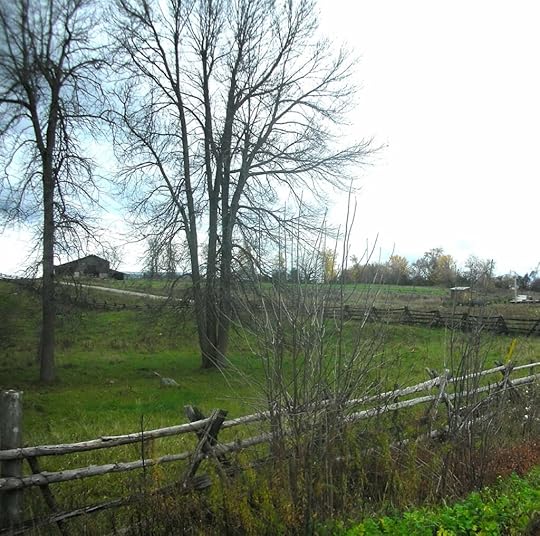
The old families of Ferguson Falls: Badour, Bennett, Blair, Byrne, Byrnes, Carberry, Closs, Craig, Cooke, Cullen, Cunningham, Cuthbertson, Dickenson, Donnelly, Doroway, Doyle, Ebbs, Ferguson, Finlayson, Forrest, Giles, Gommersall, Grey, Haley, Harrington, Hartney, Hicks, Hickey, Hogan, Hollinger, Horricks, Ireton, Keefe, Kehoe, Kenny, Little, McCaffrey, McEwen, McFarlane, McGarry, McIntyre, McIlquham, McLaughlin, McLenaghan, McNaughton, Montgomery, Moran, Moulton, Murphy, Murray, Nagel, Neville, O’Connor, O’Keefe, O’Sullivan, Phelan, Poole, Power, Price, Quinn, Rathwell, Robinson, Rothwell, Richards, Ruttle, Ryan, Scanlon, Spence, Stafford, Sullivan, Traill, Tullis.

For more information on Ferguson Falls and St. Patrick’s Roman Catholic Church: https://arlenestaffordwilson.wordpress.com/2012/07/06/st-patricks-church-fergusons-falls-lanark-county/
For Thomas Stafford’s account of the “Cattle Drives in Ferguson Falls” in “Lanark County Chronicle: Double Back to the Third Line”

For the legend of Jimmy Whelan, – “The Ghost of Ferguson Falls” – “Lanark County Calling: All Roads Lead Home”
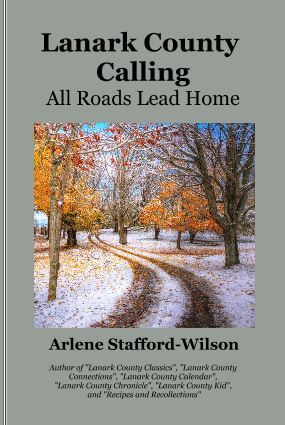
The story of “The Stumble Inn of Ferguson Falls”, from the book “Lanark County Collection”
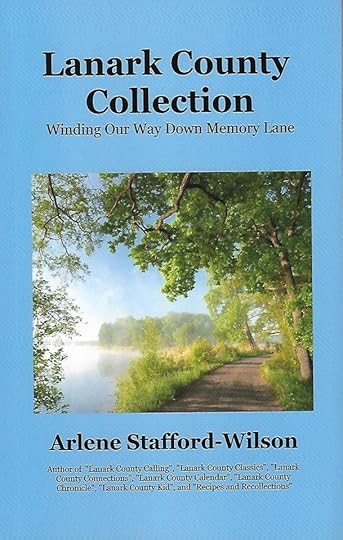
.
 Arlene Stafford-Wilson
Arlene Stafford-WilsonMember, Association of Professional Genealogists
Honorary Life Member, Lanark County Genealogical Society
Lanark County Pioneer Families Humanitarian Award
Francois Bregha Storyteller Award
Author of : “Lanark County Christmas”, “Lanark County Comfort”, “Lanark County Collection”, “Lanark County Calling”, “Lanark County Classics”, “Lanark County Connections”, “Lanark County Calendar”, “Lanark County Chronicle”, “Lanark County Kid”, & “Recipes & Recollections”, and “Lanark County Kitchen: A Maple Legacy from Tree to Table”, and “Lanark County Classrooms: Remembering Our School Days”.
March 12, 2025
Drummond Pioneer Irish Boxty

Many of the early settlers in Lanark County, arrived in 1816, like our pioneer ancestor, Tobias Stafford. He came from County Wexford, married the lovely Elizabeth ‘Betsy’ McGarry, from County Westmeath, and after a year spent living on Stafford Island, not far from Ferguson’s Falls, built a home on Lot 10, 11th Concession of Drummond Township.
One of the recipes brought from their native southern Ireland, was for Irish Boxty. It was a simple dish, made with ingredients on hand. In those days, it was a very long trip by horse and buggy to Perth, for supplies. Many of the early recipes relied on staples, ingredients available in the cupboard, at home.
As some may already know, the Irish love their limericks, and poems, and there is a little rhyme about Boxty, that was often recited with a wink and a smile. Although it is not very politically-correct in these times, it gives us a glimpse into the things of the past, that were popular in the early days:
“Boxty on the griddle,Boxty in the pan,
If you can’t make boxty,
You’ll never get your man”
Recipe for Boxty/ Irish Potato Cakes
2 c mashed potatoes
1 Tbsp flour
2 Tbsp milk
1 Tbsp grated onion
1 egg, beaten
Mix all ingredients together, shape into patties, and fry in a greased pan, until golden brown. (salt and pepper to taste) Serve with eggs, breakfast meats, and hot buttered toast.

(enjoy with a cup of hot Irish breakfast tea, or hot black tea, as our parents did)

This old recipe, in its simplicity, may not be diverse enough for the modern palate, and some may wish to add spices or vegetables into the mix.
Mother and Dad enjoyed plain food that wouldn’t upset their stomachs, and this certainly fits the bill.
and…never to be forgotten, the ritual that always came before any meal at the Stafford home, was the grace:
“Heavenly Father,
Bless this food to our use,
and us, for thy service”
Amen

………….
For more information on the early Irish settlers of Drummond Township, and St. Patrick’s church:
St. Patrick’s Church, Drummond Township
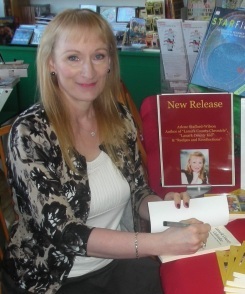
Arlene Stafford-Wilson
Member, Association of Professional GenealogistsHonorary Life Member, Lanark County Genealogical SocietyLanark County Pioneer Families Humanitarian AwardFrancois Bregha Storyteller AwardAuthor of : “Lanark County Christmas”, “Lanark County Comfort”, “Lanark County Collection”, “Lanark County Calling”, “Lanark County Classics”, “Lanark County Connections”, “Lanark County Calendar”, “Lanark County Chronicle”, “Lanark County Kid”, & “Recipes & Recollections”, “Lanark County Kitchen: A Maple Legacy from Tree to Table”, and “Lanark County Classrooms: Remembering Our School Days”.Recipe for Irish Boxty/Potato Pancakes – is from “Recipes and Recollections: Treats and Tales from our Mother’s Kitchen” ISBN: 9780987-7026-09




